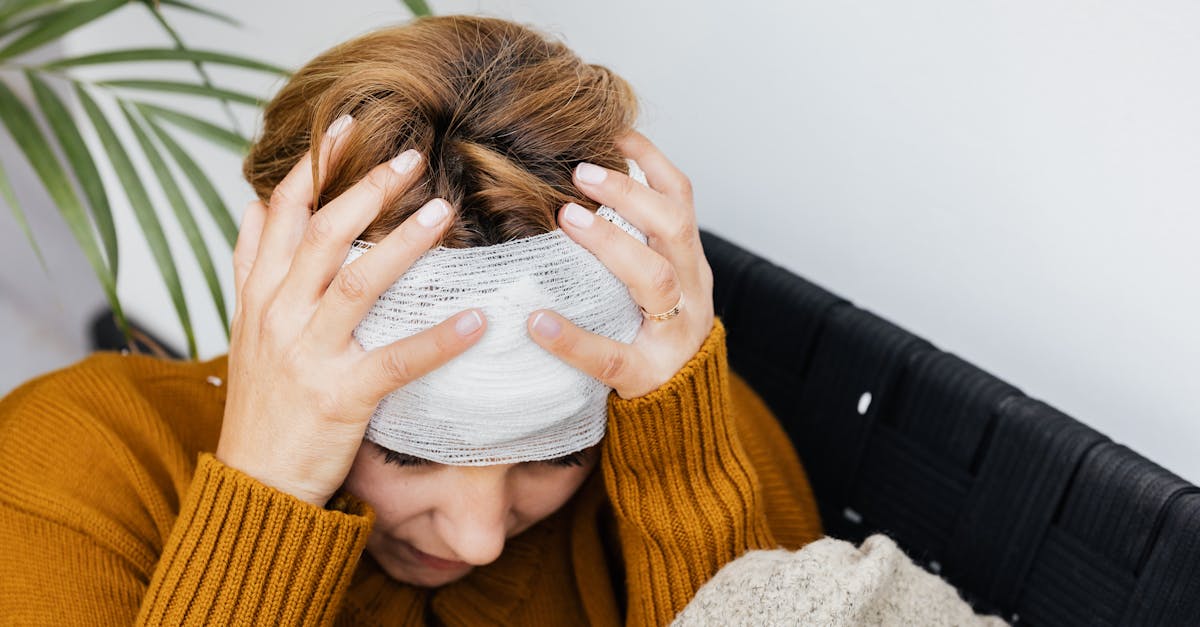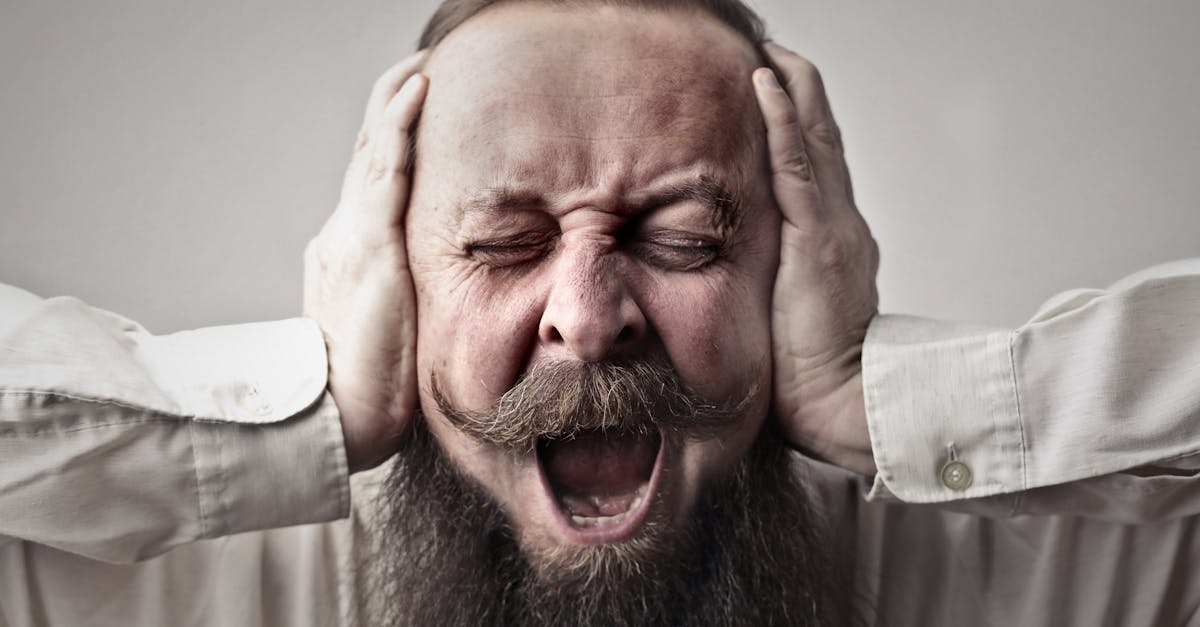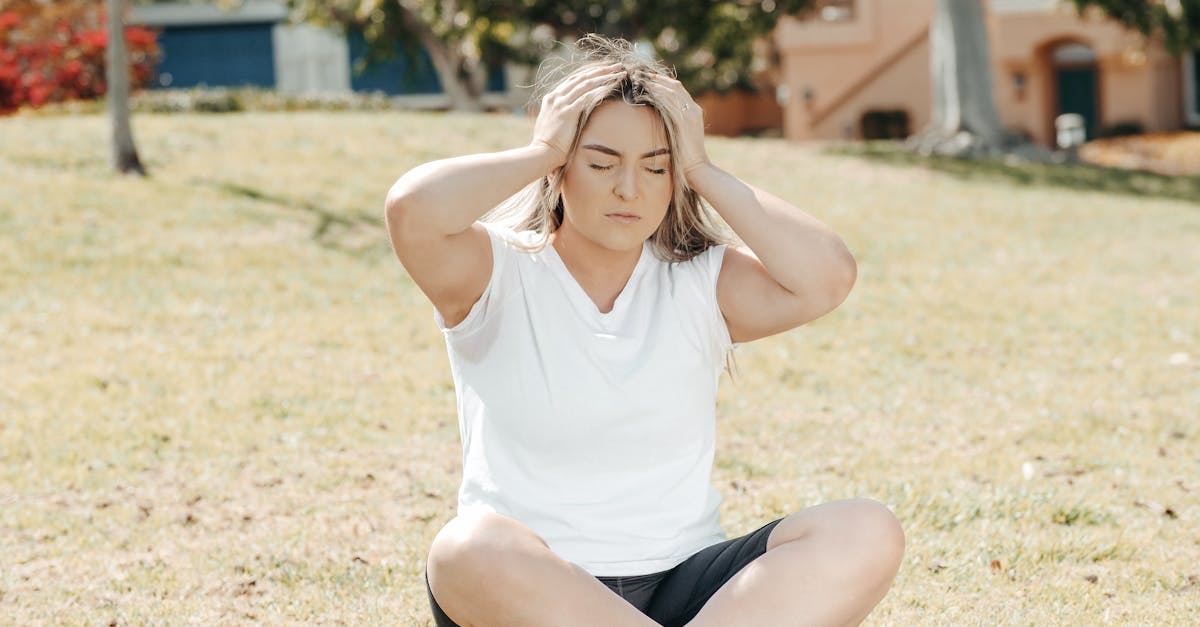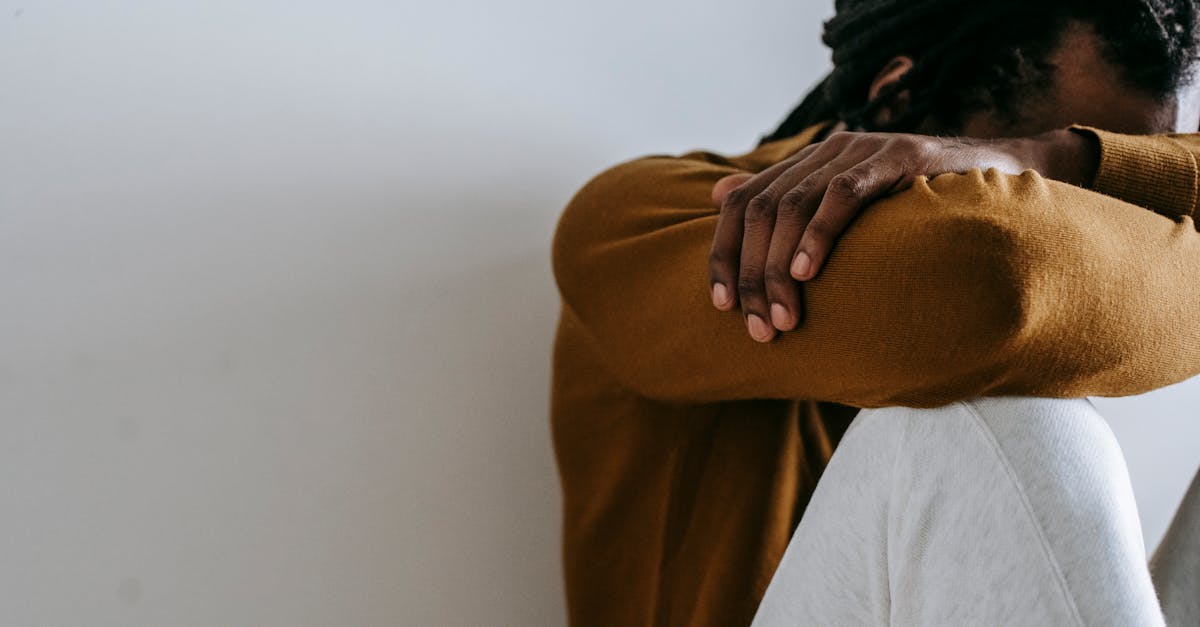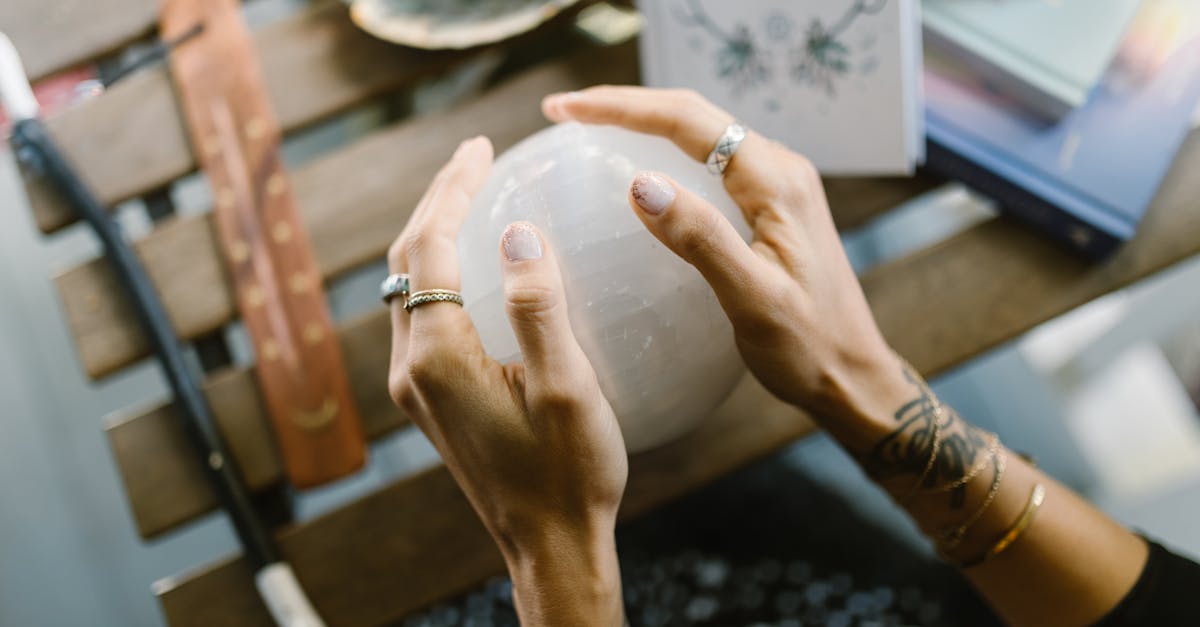Vous luttez contre les déclencheurs de migraines et cherchez des solutions ?
En bref : Les déclencheurs de migraines vous causent-ils douleur et inconfort ? Comprendre les causes des maux de tête à l’origine de la douleur migraineuse peut vous permettre de trouver des remèdes naturels efficaces contre les maux de tête. Chez Pulse Align, nous nous concentrons sur l’identification des schémas spécifiques associés aux céphalées de tension et aux céphalées hormonales, grâce à une méthode unique de recalibrage postural qui met l’accent sur des techniques holistiques pour soulager les maux de tête. Reprenez votre santé et votre bien-être en main aux cliniques Pulse Align. Prenez rendez-vous dès aujourd’hui ! Vous luttez contre les déclencheurs de migraines et cherchez des solutions ? Explorer les déclencheurs de migraines : Pulse Align est-il la solution pour identifier les schémas ? Comprendre les causes spécifiques de vos maux de tête peut vous permettre de découvrir des remèdes naturels efficaces contre les maux de tête. Chez Pulse Align, nous sommes spécialisés dans l’identification des déclencheurs associés aux migraines chroniques, aux migraines vestibulaires et aux céphalées de tension. En nous concentrant sur la correction posturale, le renforcement musculaire et l’exploration des huiles essentielles contre les maux de tête, notre approche unique vise à soulager durablement les maux de tête en s’attaquant aux causes profondes plutôt qu’aux symptômes. Rejoignez-nous pour découvrir les mécanismes complexes de vos maux de tête et retrouver votre bien-être. Découvrez des informations essentielles sur les migraines, notamment les symptômes courants, les déclencheurs potentiels, les options de traitement efficaces et des conseils sur la prévention et la gestion de la douleur. Trouvez un soulagement et des conseils pour gérer les migraines. « `html Comprendre votre bien-être : comment Pulse Align peut vous aider à retrouver votre santé
Dans notre quête d’un bien-être optimal, il est essentiel de comprendre comment nos habitudes quotidiennes et nos choix de vie affectent notre posture et notre santé globale. Vous souffrez peut-être d’inconfort ou de tensions qui influencent votre qualité de vie. Avez-vous déjà pensé à la façon dont la recalibration neuromusculaire peut vous aider à retrouver un équilibre et un dynamisme plus profonds ?
Présentation de l’approche Pulse Align Les bienfaits holistiques d’un recalibrage en douceur L’un des principaux avantages de Pulse Align réside dans son approche holistique. En stimulant les capacités d’auto-guérison du corps, les clients ressentent souvent une sensation de renouveau grâce à une posture et un équilibre naturels améliorés. En s’attaquant à la source de l’inconfort, ils peuvent adopter un mode de vie plus confortable et actif. De nombreuses personnes ont partagé leur expérience de bien-être et de vitalité après avoir adopté la méthode Pulse Align. Les clients ont exprimé leur satisfaction quant à l’accompagnement en douceur de Pulse Align. Nombre d’entre eux ont constaté une amélioration de leur posture après seulement quelques séances, leur permettant de s’investir pleinement dans leurs activités quotidiennes. Par exemple, un client a récemment souligné comment il pouvait améliorer sa posture naturellementRejoignez-nous chez Pulse Align Si vous souhaitez retrouver votre santé en mettant l’accent sur l’amélioration de votre posture et votre bien-être général, nous vous invitons à explorer les services offerts par Pulse Align. Avec des cliniques à Montréal, La Prairie, Terrebonne, Chicoutimi, Charlesbourg, Saint-Jérôme, Châteauguay, Sainte-Marie, Les Escoumins, Granby et Panama City, il y a une clinique Pulse Align près de chez vous pour vous accompagner dans votre démarche bien-être. Faites le premier pas vers un avenir plus sain en prenant rendez-vous dès aujourd’hui ! N’oubliez pas que Pulse Align s’engage à accompagner votre parcours bien-être. Notre approche douce et non invasive respecte les capacités naturelles du corps, garantissant à chaque client un sentiment de bien-être optimal. Avis de non-responsabilité médicale Les informations fournies sur ce site ne remplacent pas l’avis, le diagnostic ou le traitement d’un professionnel de santé. Consultez toujours votre médecin pour toute question médicale. Pour plus d’informations, veuillez consulter nos mentions légales complètes. https://www.youtube.com/watch?v=h5b42dUXbHw Exploration des déclencheurs de migraines : Pulse Align pourrait-il aider à identifier des schémas ? Comprendre les changements hormonaux : Reconnaître l’influence des cycles menstruels sur l’intensité des migraines. Évaluer la qualité du sommeil : Évaluer l’impact des habitudes de sommeil sur la fréquence des maux de tête.
Identifier les aliments comme le fromage et le chocolat susceptibles de déclencher des migraines.
Surveiller le niveau de stress :
Comprendre le lien entre le stress et l’apparition des maux de tête. Évaluation des facteurs environnementaux : Observation de l’effet des changements climatiques sur les migraines. Conscience posturale : Analyse de l’impact d’une mauvaise posture sur les céphalées de tension.
Activité physique :
Exploration des effets de l’exercice sur la survenue des migraines. Santé neuromusculaire : Étude de l’équilibre musculaire et de sa corrélation avec les symptômes des maux de tête. Apprenez-en davantage sur les symptômes, les causes et les options de traitement efficaces des migraines. Découvrez des conseils de prévention et d’adaptation de votre mode de vie pour gérer les migraines et améliorer votre qualité de vie. « `html Soulager les migraines et les maux de tête ne devrait pas être une tâche complexe. Chez Pulse Align, nous nous concentrons sur l’exploration des déclencheurs de migraines et utilisons une approche holistique intégrant la santé neuromusculaire, l’amélioration de la posture et le recalibrage holistique. Comprendre les causes des maux de tête et identifier les schémas peut faire une différence significative dans la gestion et la recherche de remèdes naturels efficaces contre les maux de tête. Découvrez comment Pulse Align vise à autonomiser les individus en proposant des solutions innovantes pour traiter les maux de tête chroniques et
Céphalées de tension
. Comprendre les déclencheurs de la migraine Les déclencheurs de la migraine varient d’une personne à l’autre et peuvent être influencés par plusieurs facteurs. En examinant la douleur migraineuse d’un point de vue holistique, nous pouvons identifier les causes profondes de l’inconfort. La tension, les changements hormonaux, les choix alimentaires et une mauvaise posture ne sont que quelques-uns des facteurs pouvant aggraver les migraines. Par exemple, les personnes souffrant de nausées accompagnées de maux de tête peuvent constater un lien entre leurs symptômes et des déclencheurs alimentaires spécifiques ou un niveau de stress.
Le rôle de la correction posturale dans la gestion de la migraine
Chez Pulse Align, nous insistons sur le lien essentiel entre la posture et le soulagement des maux de tête. Une mauvaise posture peut entraîner des maux de tête derrière les yeux et une douleur accrue lorsqu’elle est associée à des tensions musculaires. La mise en œuvre de techniques de correction posturale soulage non seulement l’inconfort actuel, mais favorise également des bienfaits à long terme pour la santé. Nos spécialistes aident nos clients à élaborer des programmes structurés intégrant des exercices de renforcement musculaire et du tronc, conçus pour améliorer l’alignement du corps. Techniques de recalibrage holistiques En tant que défenseurs de la guérison holistique, nous reconnaissons la valeur des thérapies qui favorisent un équilibre naturel du corps. Les techniques de recalibrage holistique utilisées chez Pulse Align aident à soulager les migraines chroniques et les céphalées hormonales. Ces approches traitent les tensions musculaires et les désalignements des systèmes neuromusculaires, améliorant ainsi le fonctionnement global de l’organisme. Nos clients ont constaté des améliorations significatives et ont trouvé un soulagement grâce à nos conseils d’experts. Mise en œuvre de stratégies pratiques pour la gestion des maux de tête Trouver des solutions efficaces pour la gestion des maux de tête commence par l’éducation et la personnalisation. Chez Pulse Align, nos programmes d’exercices personnalisés se concentrent sur les facteurs déclenchants des migraines et proposent à nos clients des stratégies pratiques pour y faire face. Nous proposons des ressources précieuses, notamment des conseils sur les aliments déclencheurs de migraines, comme le fromage et le chocolat, et encourageons l’adhésion continue à un régime alimentaire adapté à la migraine. Bénéfices de la thérapie par ondes de choc
Pour les personnes souffrant de douleurs chroniques, nos cliniques utilisent également des thérapies de pointe, dont la thérapie par ondes de choc. Ce traitement non invasif a démontré son efficacité pour réduire les tensions musculaires et favoriser la guérison des zones affectées. Nos spécialistes dévoués adaptent les séances de thérapie par ondes de choc aux besoins individuels, garantissant ainsi une amélioration significative de la gestion de la migraine.
Rejoignez la famille Pulse Align dès aujourd’hui Si vous souhaitez redéfinir votre approche du soulagement des migraines, nous vous invitons à prendre rendez-vous avec Pulse Align. Nos cliniques de Montréal, La Prairie et Panama City sont équipées pour vous proposer des évaluations complètes et des programmes d’exercices personnalisés, adaptés à vos besoins spécifiques. Laissez-nous vous accompagner dans votre cheminement vers une santé et un bien-être optimaux en vous aidant à comprendre le lien entre les déclencheurs de migraines, l’amélioration de la posture et le recalibrage holistique. Exploration des déclencheurs de migraines Déclencheurs de migraines Informations sur Pulse Align
Stress
Techniques de gestion efficaces recommandées.
Habitudes de sommeil Accent mis sur le maintien de routines de sommeil régulières. Influences alimentaires
Identification des déclencheurs alimentaires courants ; sensibilisation.
Changements hormonaux
Se concentre sur le suivi des cycles menstruels pour une meilleure gestion. HydratationEncourage une consommation suffisante de liquide pour prévenir les maux de tête. PostureSouligne l’importance des techniques de correction posturale. Activité physiqueRecommande des programmes d’exercices personnalisés pour réduire les facteurs déclenchants. Facteurs environnementauxConseils pour s’adapter aux conditions météorologiques qui provoquent des migraines. Santé neuromusculaireSe concentre sur l’équilibre et le tonus musculaire pour gérer les symptômes. Découvrez des informations essentielles sur les migraines, notamment les symptômes courants, les causes possibles, les traitements efficaces et des conseils de prévention. Apprenez à gérer les crises de migraine et à améliorer votre qualité de vie.Témoignages de clients : Transformer le bien-être et retrouver l’équilibre À La Prairie, des clients ont partagé leurs expériences remarquables avec Pulse Align, soulignant comment l’approche unique d’identification des déclencheurs de migraines les a aidés dans leur cheminement vers le bien-être. Un client a déclaré : « J’étais sceptique au début, mais en quelques séances seulement, j’ai constaté une réduction significative de la fréquence de mes maux de tête. Les techniques holistiques ont véritablement permis à mon corps de se rééquilibrer, rétablissant l’équilibre d’une manière que je n’aurais jamais cru possible. »Des clients de Mont-Royal ont rapporté avec enthousiasme des transformations positives similaires. Un résident a déclaré : « Le personnel de Pulse Align m’a non seulement aidé à identifier mes déclencheurs de migraines spécifiques, mais m’a également fourni des stratégies pratiques pour gérer mes symptômes. J’ai ressenti un regain de vitalité et d’engagement dans ma vie quotidienne. » L’environnement bienveillant créé par Pulse Align a eu un impact incroyable sur leur bien-être général. À Terrebonne, les personnes ont grandement bénéficié des soins complets de Pulse Align. Un client a déclaré : « Après avoir souffert de migraines chroniques pendant des années, je me sens enfin écouté et compris. Les méthodes utilisées ici privilégient la capacité naturelle de mon corps à guérir, ce qui a entraîné des améliorations que je croyais impossibles. » Ce sentiment résonne dans toute la région de Chicoutimi, où des clients ont partagé leur soulagement de l’inconfort grâce aux techniques douces et encourageantes employées chez Pulse Align.Si vous habitez à Saint-Jérôme ou à Châteauguay, pensez à visiter Pulse Align pour découvrir comment leur approche innovante peut vous aider à gérer efficacement les déclencheurs de migraines. Nos clients constatent régulièrement des bienfaits significatifs grâce à ces services, leur permettant de retrouver naturellement leur bien-être. Explorez la voie vers une meilleure santé en consultant
Nos cliniques et découvrez comment Pulse Align peut vous accompagner dans votre démarche de bien-être dès aujourd’hui. Vous souffrez de déclencheurs de migraines et cherchez un soulagement efficace ? Comprendre les causes des maux de tête
à l’origine de la douleur migraineuse
peut vous permettre de trouver des remèdes naturels efficaces. Axée sur l’identification de schémas spécifiques de céphalées de tension et céphalées hormonales , notre approche chez
Pulse Align
met l’accent sur des techniques holistiques pour soulager les maux de tête. Nos cliniques proposent une méthode unique et simple de recalibrage postural qui peut vous aider à retrouver votre bien-être. En reconnaissant les schémas associés à la douleur migraineuse, les personnes peuvent gérer leurs symptômes plus efficacement. Une attention particulière est portée à des facteurs tels que les facteurs déclenchants alimentaires, la qualité du sommeil, la gestion du stress et l’hydratation. L’approche bien-être douce de Pulse Align Chez Pulse Align, nous nous concentrons sur la promotion de la symétrie du tonus musculaire et l’amélioration des fonctions corporelles naturelles. Nos techniques de stimulation douce soutiennent la capacité du corps à retrouver son équilibre tout en éliminant les tensions et les déséquilibres. En créant un environnement calme, nous facilitons un processus qui permet aux clients d’améliorer leur bien-être au quotidien. Les bienfaits holistiques de la médecine naturelle
Choisir une approche holistique, c’est opter pour des méthodes qui exploitent les capacités d’auto-guérison du corps. Nos clients partagent souvent des retours positifs sur la façon dont Pulse Align a favorisé des transformations personnelles significatives. Les techniques bienveillantes que nous utilisons favorisent non seulement le bien-être physique, mais aussi la vitalité globale, permettant aux clients de s’investir plus pleinement dans leur quotidien.
Notre mission Chez Pulse Align, notre mission est de proposer des traitements fondés sur des données probantes et centrés sur le patient, qui s’attaquent aux causes sous-jacentes de la douleur et des dysfonctionnements. En intégrant des techniques et des technologies de pointe, nous nous efforçons de permettre à chaque personne de prendre en main sa santé, en garantissant des soins de haute qualité, un soulagement durable et une meilleure qualité de vie. Prêt à découvrir les avantages de cette approche ? Contactez Pulse Align pour en savoir plus et PRENEZ RENDEZ-VOUS dès aujourd’hui ! Découvrez nos services sur
www.pulsealign.com
et trouvez un centre près de chez vous ici . Découvrez les avantages de la thérapie avancée de décompression vertébrale de TAGMED Souffrez-vous de douleurs ou d’inconfort chroniques dus à des affections telles qu’une
hernie discale
,
un bombement discal
ou
une
sténose spinale ? La thérapie avancée de décompression vertébrale de TAGMED
offre une solution non chirurgicale spécialement conçue pour traiter les problèmes discaux modérés à sévères. En réduisant doucement la pression exercée sur les disques et les nerfs affectés, cette technique spécialisée améliore la mobilité, soulage la douleur et favorise le processus naturel de guérison de votre corps. Si vous stagnez avec d’autres thérapies, découvrez comment l’approche de décompression fondée sur des données probantes de TAGMED peut vous permettre de reprendre une vie active et confortable.
Avez-vous essayé les traitements conventionnels et souffrez-vous toujours de maux de dos persistants ou de sciatique ?
Mécanisme d’action
La décompression neurovertébrale de TAGMED consiste à appliquer une force de traction contrôlée et progressive sur la colonne vertébrale. Cette méthode innovante augmente l’espace entre les vertèbres, réduisant ainsi efficacement la pression exercée sur les
disques intervertébraux
et les
racines nerveuses
. En favorisant une meilleure circulation des fluides dans la zone ciblée, ce processus contribue à réduire l’inflammation et à soulager la douleur, ce qui en fait une solution fiable et non invasive pour les personnes souffrant de
problèmes de dos chroniques
.
Avantages spécifiques
L’approche non invasive de la thérapie TAGMED peut soulager efficacement la douleur chronique et les symptômes liés à des affections telles que les
hernies discales
et
la
sténose spinale
La thérapie réduit significativement la pression sur les structures nerveuses et optimise la circulation des fluides autour des disques intervertébraux, facteurs qui peuvent accélérer la guérison et améliorer la qualité de vie d’un large éventail de patients cherchant à soulager une gêne persistante. De nombreux patients ont signalé une amélioration significative de leurs douleurs cervicales , ce qui leur a permis d’adopter un mode de vie plus actif.
Comparaison avec d’autres traitements
La technologie de décompression neurovertébrale TAGMED est comparée à d’autres traitements couramment utilisés. Contrairement aux méthodes traditionnelles telles que les analgésiques, les injections de corticostéroïdes ou la chirurgie, qui comportent souvent des risques et des complications, la thérapie TAGMED offre une alternative plus sûre avec des risques médicamenteux minimisés. Grâce à sa nature non invasive, les patients bénéficient généralement d’un rétablissement plus rapide, leur permettant de reprendre une vie normale sans le fardeau de la douleur chronique.
De nombreux exemples concrets soulignent l’efficacité de la décompression neurovertébrale TAGMED dans le traitement de la douleur chronique et d’autres symptômes associés. Des patients ont partagé des témoignages exprimant leur soulagement de douleurs dorsales et de sciatiques chroniques. Par exemple, un patient a signalé une réduction remarquable de la douleur après seulement quelques séances, lui permettant de reprendre rapidement ses activités favorites. Ce type de retour positif démontre les résultats tangibles et les avantages pratiques de cette approche thérapeutique.
Avec la thérapie de décompression vertébrale de TAGMED, découvrez une voie vers le soulagement qui favorise votre bien-être général et améliore votre qualité de vie. Découvrez par vous-même la différence que ce traitement innovant et non invasif peut apporter.
Conclusion : Découvrez les bienfaits de Pulse Align pour les déclencheurs de migraines
Si vous faites face aux défis liés aux déclencheurs de migraines, il est essentiel de comprendre les causes de votre inconfort. Chez Pulse Align, notre approche holistique se concentre sur la promotion de la correction posturale
et
Recalibrage neuromusculaire . Nos clients ont constaté une amélioration significative de leur bien-être, notamment une meilleure posture, une réduction de l’inconfort et une mobilité accrue grâce à nos techniques douces et non invasives. Nos clients partagent souvent leurs expériences positives avec Pulse Align, soulignant comment l’accent que nous mettons sur le soulagement naturel de la douleur et la capacité naturelle du corps à guérir a transformé leur vie. Grâce à des soins personnalisés et à une communauté de soutien, les clients se sentent capables de prendre en main leur parcours de bien-être et d’adopter un mode de vie plus dynamique et sain.
Nous vous invitons à découvrir la différence Pulse Align dès aujourd’hui. Votre chemin vers un bien-être accru commence ici. Prenez rendez-vous dès maintenant pour en savoir plus sur nos services et découvrir comment ils peuvent compléter votre routine bien-être sans remplacer les soins médicaux essentiels. Saisissez l’opportunité d’une vie plus saine et plus équilibrée avec Pulse Align, où nous nous concentrons sur le soutien des capacités naturelles de guérison de votre corps. Découvrez notre approche en visitant notre site web et faites le premier pas vers le bien-être. Apprenez-en plus sur les migraines : symptômes, causes, déclencheurs et traitements efficaces. Trouvez des conseils pour gérer et prévenir les crises de migraine et améliorer votre bien-être. Souffrez-vous d’une maladie chronique qui répond peu ou pas aux traitements conventionnels ? Chez Pulse Align, nous explorons les facteurs contribuant à l’inconfort, en nous concentrant sur des méthodes innovantes et non invasives conçues pour restaurer l’équilibre et l’alignement naturels de votre corps. Notre approche utilise des impulsions douces et imperceptibles qui peuvent réduire les tensions musculaires et articulaires, vous offrant ainsi un chemin vers un bien-être amélioré sans recours à des interventions médicales traditionnelles. Pulse Align ne traite pas directement des affections ou des symptômes spécifiques. Nous nous concentrons plutôt sur l’aide efficace que votre corps apporte à son recalibrage naturel. Nombre de nos clients constatent une amélioration remarquable de leur confort et de leur posture grâce à notre approche douce. En rétablissant l’équilibre naturel de votre corps, vous constaterez peut-être une diminution des tensions quotidiennes, vous procurant ainsi une sensation de vitalité et de bien-être accrue. Notre approche personnalisée est adaptée aux besoins uniques de chaque client, et nous avons reçu des commentaires encourageants de ceux qui ont fait appel à nos services. Nos clients constatent souvent une amélioration significative de leurs tensions musculaires et de leur bien-être général, se sentant plus équilibrés et harmonisés dans leurs activités quotidiennes. Notre approche holistique axée sur la symétrie du tonus musculaire s’harmonise naturellement avec votre cheminement vers un confort et un bien-être accrus. Nous vous invitons à consulter le site web de Pulse Align pour en savoir plus sur nos services et trouver des cliniques à proximité, notamment à La Prairie, Mont-Royal, Terrebonne et bien d’autres. Prendre rendez-vous pour une consultation est simple et nous vous encourageons à considérer Pulse Align comme une partie intégrante du parcours de bien-être de votre famille. N’oubliez pas que notre approche est conçue pour compléter vos soins de santé habituels plutôt que pour les remplacer. Explorez l’opportunité d’adopter une méthode sûre et non invasive pour améliorer votre alignement et votre bien-être.
Pulse Align . Rejoignez-nous chez Pulse Align et faites le premier pas vers un sentiment revitalisé d’alignement et de tranquillité pour vous et votre famille !
Frequently Asked Questions
Maux de tête et migraines
Les fluctuations de la glycémie déclenchent-elles des migraines ?
Une hypoglycémie (trop peu de sucre dans le sang) peut déclencher une crise chez certaines personnes.
La posture influence-t-elle la survenue des maux de tête ?
Une mauvaise posture peut causer des tensions cervicales et contribuer aux maux de tête.
Combien de temps dure une crise de migraine ?
Une crise de migraine peut durer de quelques heures à trois jours si elle n’est pas traitée.
La coenzyme Q10 ou le magnésium aident-ils ?
Certaines études suggèrent que la supplémentation en magnésium ou en coenzyme Q10 peut réduire la fréquence des migraines.
Le stress est-il un facteur déclenchant ?
Oui, le stress émotionnel ou physique est l’un des déclencheurs les plus fréquents des maux de tête et des migraines.
Les écrans aggravent-ils les maux de tête ?
Oui, une exposition prolongée aux écrans peut fatiguer les yeux, provoquer des tensions et déclencher des maux de tête.
L’aura est-elle présente dans toutes les migraines ?
Non, seulement environ 20% des personnes migraineuses présentent une aura avant la crise.
Les migraines sont-elles plus fréquentes chez les femmes ?
Oui, en raison des fluctuations hormonales, les femmes sont plus souvent touchées que les hommes.
L’hydratation régulière prévient-elle les maux de tête ?
Oui, rester hydraté est un moyen simple de réduire le risque de maux de tête liés à la déshydratation.
Les thérapies alternatives (acupuncture) sont-elles utiles ?
Certaines personnes trouvent du soulagement avec l’acupuncture, bien que l’efficacité varie d’un individu à l’autre.
References No parsed citations found. Full shortcode output:
722490
MDAVM6MK
1
apa
20
default
14662
https://pulsealignmontroyal.com/wp-content/plugins/zotpress/
%7B%22status%22%3A%22success%22%2C%22updateneeded%22%3Afalse%2C%22instance%22%3Afalse%2C%22meta%22%3A%7B%22request_last%22%3A0%2C%22request_next%22%3A0%2C%22used_cache%22%3Atrue%7D%2C%22data%22%3A%5B%7B%22key%22%3A%22474E5C2I%22%2C%22library%22%3A%7B%22id%22%3A722490%7D%2C%22meta%22%3A%7B%22creatorSummary%22%3A%22Al-Khazali%20et%20al.%22%2C%22parsedDate%22%3A%222024%22%2C%22numChildren%22%3A1%7D%2C%22bib%22%3A%22%26lt%3Bdiv%20class%3D%26quot%3Bcsl-bib-body%26quot%3B%20style%3D%26quot%3Bline-height%3A%202%3B%20padding-left%3A%201em%3B%20text-indent%3A-1em%3B%26quot%3B%26gt%3B%5Cn%20%20%26lt%3Bdiv%20class%3D%26quot%3Bcsl-entry%26quot%3B%26gt%3BAl-Khazali%2C%20H.%20M.%2C%20Al-Sayegh%2C%20Z.%2C%20Younis%2C%20S.%2C%20Christensen%2C%20R.%20H.%2C%20Ashina%2C%20M.%2C%20Schytz%2C%20H.%20W.%2C%20%26amp%3B%20Ashina%2C%20S.%20%282024%29.%20Systematic%20review%20and%20meta-analysis%20of%20Neck%20Disability%20Index%20and%20Numeric%20Pain%20Rating%20Scale%20in%20patients%20with%20migraine%20and%20tension-type%20headache.%20%26lt%3Bi%26gt%3BCephalalgia%26lt%3B%5C%2Fi%26gt%3B%2C%20%26lt%3Bi%26gt%3B44%26lt%3B%5C%2Fi%26gt%3B%288%29%2C%2003331024241274266.%20%26lt%3Ba%20class%3D%26%23039%3Bzp-DOIURL%26%23039%3B%20href%3D%26%23039%3Bhttps%3A%5C%2F%5C%2Fdoi.org%5C%2F10.1177%5C%2F03331024241274266%26%23039%3B%26gt%3Bhttps%3A%5C%2F%5C%2Fdoi.org%5C%2F10.1177%5C%2F03331024241274266%26lt%3B%5C%2Fa%26gt%3B%26lt%3B%5C%2Fdiv%26gt%3B%5Cn%26lt%3B%5C%2Fdiv%26gt%3B%22%2C%22data%22%3A%7B%22itemType%22%3A%22journalArticle%22%2C%22title%22%3A%22Systematic%20review%20and%20meta-analysis%20of%20Neck%20Disability%20Index%20and%20Numeric%20Pain%20Rating%20Scale%20in%20patients%20with%20migraine%20and%20tension-type%20headache%22%2C%22creators%22%3A%5B%7B%22creatorType%22%3A%22author%22%2C%22firstName%22%3A%22Haidar%20M.%22%2C%22lastName%22%3A%22Al-Khazali%22%7D%2C%7B%22creatorType%22%3A%22author%22%2C%22firstName%22%3A%22Zainab%22%2C%22lastName%22%3A%22Al-Sayegh%22%7D%2C%7B%22creatorType%22%3A%22author%22%2C%22firstName%22%3A%22Samaira%22%2C%22lastName%22%3A%22Younis%22%7D%2C%7B%22creatorType%22%3A%22author%22%2C%22firstName%22%3A%22Rune%20H.%22%2C%22lastName%22%3A%22Christensen%22%7D%2C%7B%22creatorType%22%3A%22author%22%2C%22firstName%22%3A%22Messoud%22%2C%22lastName%22%3A%22Ashina%22%7D%2C%7B%22creatorType%22%3A%22author%22%2C%22firstName%22%3A%22Henrik%20W.%22%2C%22lastName%22%3A%22Schytz%22%7D%2C%7B%22creatorType%22%3A%22author%22%2C%22firstName%22%3A%22Sait%22%2C%22lastName%22%3A%22Ashina%22%7D%5D%2C%22abstractNote%22%3A%22Background%5Cn%20%20%20%20%20%20%20%20%20%20%20%20%20%20The%20present%20study%20aimed%20to%20assess%20the%20burden%20of%20neck%20pain%20in%20adults%20with%20migraine%20and%20tension-type%20headache%20%28TTH%29%2C%20utilizing%20the%20Neck%20Disability%20Index%20%28NDI%29%20and%20Numeric%20Pain%20Rating%20Scale%20%28NPRS%29.%5Cn%20%20%20%20%20%20%20%20%20%20%20%20%5Cn%20%20%20%20%20%20%20%20%20%20%20%20%5Cn%20%20%20%20%20%20%20%20%20%20%20%20%20%20Methods%5Cn%20%20%20%20%20%20%20%20%20%20%20%20%20%20%5Cn%20%20%20%20%20%20%20%20%20%20%20%20%20%20%20%20A%20systematic%20literature%20search%20was%20conducted%20on%20PubMed%20and%20Embase%20to%20identify%20observational%20studies%20assessing%20NDI%20and%20NPRS%20in%20populations%20with%20migraine%20or%20TTH.%20The%20screening%20of%20articles%20was%20independently%20performed%20by%20two%20investigators%20%28HMA%20and%20ZA%29.%20Pooled%20mean%20estimates%20were%20calculated%20through%20random-effects%20meta-analysis.%20The%20I%5Cn%20%20%20%20%20%20%20%20%20%20%20%20%20%20%20%202%5Cn%20%20%20%20%20%20%20%20%20%20%20%20%20%20%20%20statistic%20assessed%20between-study%20heterogeneity%2C%20and%20meta-regression%20further%20explored%20heterogeneity%20factors.%5Cn%20%20%20%20%20%20%20%20%20%20%20%20%20%20%5Cn%20%20%20%20%20%20%20%20%20%20%20%20%5Cn%20%20%20%20%20%20%20%20%20%20%20%20%5Cn%20%20%20%20%20%20%20%20%20%20%20%20%20%20Results%5Cn%20%20%20%20%20%20%20%20%20%20%20%20%20%20%5Cn%20%20%20%20%20%20%20%20%20%20%20%20%20%20%20%20Thirty-three%20clinic-based%20studies%20met%20the%20inclusion%20criteria.%20For%20participants%20with%20migraine%2C%20the%20pooled%20mean%20NDI%20score%20was%2016.2%20%2895%25%20confidence%20interval%20%28CI%29%20%3D%2013.2%5Cu201319.2%2C%20I%5Cn%20%20%20%20%20%20%20%20%20%20%20%20%20%20%20%202%5Cu2009%5Cn%20%20%20%20%20%20%20%20%20%20%20%20%20%20%20%20%3D%5Cu200999%25%29.%20Additionally%2C%20the%20mean%20NDI%20was%205.5%20%2895%25%20CI%20%3D%204.11%5Cu20136.8%2C%20p%5Cu2009%26lt%3B%5Cu20090.001%29%20scores%20higher%20in%20participants%20with%20chronic%20compared%20to%20episodic%20migraine.%20The%20pooled%20mean%20NDI%20score%20for%20participants%20with%20TTH%20was%2013.7%20%2895%25%20CI%20%3D%204.9%5Cu201322.4%2C%20I%5Cn%20%20%20%20%20%20%20%20%20%20%20%20%20%20%20%202%5Cu2009%5Cn%20%20%20%20%20%20%20%20%20%20%20%20%20%20%20%20%3D%5Cu200999%25%29.%20In%20addition%2C%20the%20meta-analysis%20revealed%20a%20mean%20NPRS%20score%20of%205.7%20%2895%25%20CI%20%3D%205.1%5Cu20136.2%2C%20I%5Cn%20%20%20%20%20%20%20%20%20%20%20%20%20%20%20%202%5Cn%20%20%20%20%20%20%20%20%20%20%20%20%20%20%20%20%5Cu2009%3D%5Cu200995%25%29%20across%20all%20participants%20with%20migraine.%5Cn%20%20%20%20%20%20%20%20%20%20%20%20%20%20%5Cn%20%20%20%20%20%20%20%20%20%20%20%20%5Cn%20%20%20%20%20%20%20%20%20%20%20%20%5Cn%20%20%20%20%20%20%20%20%20%20%20%20%20%20Conclusions%5Cn%20%20%20%20%20%20%20%20%20%20%20%20%20%20This%20systematic%20review%20and%20meta-analysis%20shows%20a%20greater%20degree%20of%20neck%20pain-related%20disability%20in%20migraine%20compared%20to%20TTH.%20Nevertheless%2C%20the%20generalizability%20of%20these%20findings%20is%20constrained%20by%20methodological%20variations%20identified%20in%20the%20current%20literature.%22%2C%22date%22%3A%2208%5C%2F2024%22%2C%22language%22%3A%22en%22%2C%22DOI%22%3A%2210.1177%5C%2F03331024241274266%22%2C%22ISSN%22%3A%220333-1024%2C%201468-2982%22%2C%22url%22%3A%22https%3A%5C%2F%5C%2Fjournals.sagepub.com%5C%2Fdoi%5C%2F10.1177%5C%2F03331024241274266%22%2C%22collections%22%3A%5B%22MDAVM6MK%22%5D%2C%22dateModified%22%3A%222024-12-16T17%3A38%3A46Z%22%7D%7D%2C%7B%22key%22%3A%22UL3PWZM8%22%2C%22library%22%3A%7B%22id%22%3A722490%7D%2C%22meta%22%3A%7B%22creatorSummary%22%3A%22Fern%5Cu00e1ndez%5Cu2010de%5Cu2010las%5Cu2010Pe%5Cu00f1as%20et%20al.%22%2C%22parsedDate%22%3A%222007%22%2C%22numChildren%22%3A1%7D%2C%22bib%22%3A%22%26lt%3Bdiv%20class%3D%26quot%3Bcsl-bib-body%26quot%3B%20style%3D%26quot%3Bline-height%3A%202%3B%20padding-left%3A%201em%3B%20text-indent%3A-1em%3B%26quot%3B%26gt%3B%5Cn%20%20%26lt%3Bdiv%20class%3D%26quot%3Bcsl-entry%26quot%3B%26gt%3BFern%26%23xE1%3Bndez%26%23x2010%3Bde%26%23x2010%3Blas%26%23x2010%3BPe%26%23xF1%3Bas%2C%20C.%2C%20Cuadrado%2C%20M.%20L.%2C%20%26amp%3B%20Pareja%2C%20J.%20A.%20%282007%29.%20Myofascial%20Trigger%20Points%2C%20Neck%20Mobility%2C%20and%20Forward%20Head%20Posture%20in%20Episodic%20Tension%26%23x2010%3BType%20Headache.%20%26lt%3Bi%26gt%3BHeadache%3A%20The%20Journal%20of%20Head%20and%20Face%20Pain%26lt%3B%5C%2Fi%26gt%3B%2C%20%26lt%3Bi%26gt%3B47%26lt%3B%5C%2Fi%26gt%3B%285%29%2C%20662%26%23x2013%3B672.%20%26lt%3Ba%20class%3D%26%23039%3Bzp-DOIURL%26%23039%3B%20href%3D%26%23039%3Bhttps%3A%5C%2F%5C%2Fdoi.org%5C%2F10.1111%5C%2Fj.1526-4610.2006.00632.x%26%23039%3B%26gt%3Bhttps%3A%5C%2F%5C%2Fdoi.org%5C%2F10.1111%5C%2Fj.1526-4610.2006.00632.x%26lt%3B%5C%2Fa%26gt%3B%26lt%3B%5C%2Fdiv%26gt%3B%5Cn%26lt%3B%5C%2Fdiv%26gt%3B%22%2C%22data%22%3A%7B%22itemType%22%3A%22journalArticle%22%2C%22title%22%3A%22Myofascial%20Trigger%20Points%2C%20Neck%20Mobility%2C%20and%20Forward%20Head%20Posture%20in%20Episodic%20Tension%5Cu2010Type%20Headache%22%2C%22creators%22%3A%5B%7B%22creatorType%22%3A%22author%22%2C%22firstName%22%3A%22C%5Cu00e9sar%22%2C%22lastName%22%3A%22Fern%5Cu00e1ndez%5Cu2010de%5Cu2010las%5Cu2010Pe%5Cu00f1as%22%7D%2C%7B%22creatorType%22%3A%22author%22%2C%22firstName%22%3A%22Maria%20L.%22%2C%22lastName%22%3A%22Cuadrado%22%7D%2C%7B%22creatorType%22%3A%22author%22%2C%22firstName%22%3A%22Juan%20A.%22%2C%22lastName%22%3A%22Pareja%22%7D%5D%2C%22abstractNote%22%3A%22Objective.%5Cu2014To%20assess%20the%20differences%20in%20the%20presence%20of%20trigger%20points%20%28TrPs%29%20in%20head%20and%20neck%20muscles%2C%20forward%20head%20posture%20%28FHP%29%20and%20neck%20mobility%20between%20episodic%20tension%5Cu2010type%20headache%20%28ETTH%29%20subjects%20and%20healthy%20controls.%20In%20addition%2C%20we%20assess%20the%20relationship%20between%20these%20muscle%20TrPs%2C%20FHP%2C%20neck%20mobility%2C%20and%20several%20clinical%20variables%20concerning%20the%20intensity%20and%20the%20temporal%20profile%20of%20headache.%5Cn%20%20%20%20%20%20%20%20%20%20%20%20Background.%5Cu2014TTH%20is%20a%20headache%20in%20which%20musculoskeletal%20disorders%20of%20the%20craniocervical%20region%20might%20play%20an%20important%20role%20in%20its%20pathogenesis.%5Cn%20%20%20%20%20%20%20%20%20%20%20%20Design.%5Cu2014A%20blinded%2C%20controlled%20pilot%20study.%5Cn%20%20%20%20%20%20%20%20%20%20%20%20Methods.%5Cu2014Fifteen%20ETTH%20subjects%20and%2015%20matched%20controls%20without%20headache%20were%20studied.%20TrPs%20in%20both%20upper%20trapezius%2C%20both%20sternocleidomastoids%2C%20and%20both%20temporalis%20muscles%20were%20identified%20according%20to%20Simons%20and%20Gerwin%20diagnostic%20criteria%20%28tenderness%20in%20a%20hypersensible%20spot%20within%20a%20palpable%20taut%20band%2C%20local%20twitch%20response%20elicited%20by%20snapping%20palpation%2C%20and%20elicited%20referred%20pain%20with%20palpation%29.%20Side%5Cu2010view%20pictures%20of%20each%20subject%20were%20taken%20in%20both%20sitting%20and%20standing%20positions%2C%20in%20order%20to%20assess%20FHP%20by%20measuring%20the%20craniovertebral%20angle.%20A%20cervical%20goniometer%20was%20employed%20to%20measure%20neck%20mobility.%20All%20measures%20were%20taken%20by%20a%20blinded%20assessor.%20A%20headache%20diary%20was%20kept%20for%204%20weeks%20in%20order%20to%20assess%20headache%20intensity%2C%20frequency%2C%20and%20duration.%5Cn%20%20%20%20%20%20%20%20%20%20%20%20%5Cn%20%20%20%20%20%20%20%20%20%20%20%20%20%20Results.%5Cu2014The%20mean%20number%20of%20TrPs%20for%20each%20ETTH%20subject%20was%203.7%20%28SD%3A%201.3%29%2C%20of%20which%201.9%20%28SD%3A%200.9%29%20were%20active%2C%20and%201.8%20%28SD%3A%200.9%29%20were%20latent.%20Control%20subjects%20only%20had%20latent%20TrPs%20%28mean%3A%201.5%3B%20SD%3A%201%29.%20TrP%20occurrence%20between%20the%202%20groups%20was%20significantly%20different%20for%20active%20TrPs%20%28%5Cn%20%20%20%20%20%20%20%20%20%20%20%20%20%20P%5Cn%20%20%20%20%20%20%20%20%20%20%20%20%20%20%26lt%3B%20.001%29%2C%20but%20not%20for%20latent%20TrPs%20%28%5Cn%20%20%20%20%20%20%20%20%20%20%20%20%20%20P%5Cn%20%20%20%20%20%20%20%20%20%20%20%20%20%20%26gt%3B%20.05%29.%20Differences%20in%20the%20distribution%20of%20TrPs%20were%20significant%20for%20the%20right%20upper%20trapezius%20muscles%20%28%5Cn%20%20%20%20%20%20%20%20%20%20%20%20%20%20P%5Cn%20%20%20%20%20%20%20%20%20%20%20%20%20%20%3D%20.04%29%2C%20the%20left%20sternocleidomastoid%20%28%5Cn%20%20%20%20%20%20%20%20%20%20%20%20%20%20P%5Cn%20%20%20%20%20%20%20%20%20%20%20%20%20%20%3D%20.03%29%2C%20and%20both%20temporalis%20muscles%20%28%5Cn%20%20%20%20%20%20%20%20%20%20%20%20%20%20P%5Cn%20%20%20%20%20%20%20%20%20%20%20%20%20%20%26lt%3B%20.001%29.%20Within%20the%20ETTH%20group%2C%20headache%20intensity%2C%20frequency%2C%20and%20duration%20outcomes%20did%20not%20differ%20depending%20on%20TrP%20activity%2C%20whether%20the%20TrP%20was%20active%20or%20latent.%20The%20craniovertebral%20angle%20was%20smaller%2C%20ie%2C%20there%20was%20a%20greater%20FHP%2C%20in%20ETTH%20patients%20than%20in%20healthy%20controls%20for%20both%20sitting%20and%20standing%20positions%20%28%5Cn%20%20%20%20%20%20%20%20%20%20%20%20%20%20P%5Cn%20%20%20%20%20%20%20%20%20%20%20%20%20%20%26lt%3B%20.05%29.%20ETTH%20subjects%20with%20active%20TrPs%20in%20the%20analyzed%20muscles%20had%20a%20greater%20FHP%20than%20those%20with%20latent%20TrPs%20in%20both%20sitting%20and%20standing%20positions%2C%20though%20differences%20were%20only%20significant%20for%20certain%20muscles.%20Finally%2C%20ETTH%20patients%20also%20showed%20lesser%20neck%20mobility%20than%20healthy%20controls%20in%20the%20total%20range%20of%20motion%20as%20well%20as%20in%20half%5Cu2010cycles%20%28except%20for%20cervical%20extension%29%2C%20although%20neck%20mobility%20did%20not%20seem%20to%20influence%20headache%20parameters.%5Cn%20%20%20%20%20%20%20%20%20%20%20%20%5Cn%20%20%20%20%20%20%20%20%20%20%20%20Conclusions.%5Cu2014Active%20TrPs%20in%20the%20upper%20trapezius%2C%20sternocleidomastoid%2C%20and%20temporalis%20muscles%20were%20more%20common%20in%20ETTH%20subjects%20than%20in%20healthy%20controls%2C%20although%20TrP%20activity%20was%20not%20related%20to%20any%20clinical%20variable%20concerning%20the%20intensity%20and%20the%20temporal%20profile%20of%20headache.%20ETTH%20patients%20showed%20greater%20FHP%20and%20lesser%20neck%20mobility%20than%20healthy%20controls%2C%20although%20both%20disorders%20were%20not%20correlated%20with%20headache%20parameters.%22%2C%22date%22%3A%2205%5C%2F2007%22%2C%22language%22%3A%22en%22%2C%22DOI%22%3A%2210.1111%5C%2Fj.1526-4610.2006.00632.x%22%2C%22ISSN%22%3A%220017-8748%2C%201526-4610%22%2C%22url%22%3A%22https%3A%5C%2F%5C%2Fheadachejournal.onlinelibrary.wiley.com%5C%2Fdoi%5C%2F10.1111%5C%2Fj.1526-4610.2006.00632.x%22%2C%22collections%22%3A%5B%22MDAVM6MK%22%5D%2C%22dateModified%22%3A%222024-12-16T17%3A38%3A46Z%22%7D%7D%2C%7B%22key%22%3A%22Q6L4ZIPK%22%2C%22library%22%3A%7B%22id%22%3A722490%7D%2C%22meta%22%3A%7B%22creatorSummary%22%3A%22Bjarne%22%2C%22parsedDate%22%3A%222024%22%2C%22numChildren%22%3A1%7D%2C%22bib%22%3A%22%26lt%3Bdiv%20class%3D%26quot%3Bcsl-bib-body%26quot%3B%20style%3D%26quot%3Bline-height%3A%202%3B%20padding-left%3A%201em%3B%20text-indent%3A-1em%3B%26quot%3B%26gt%3B%5Cn%20%20%26lt%3Bdiv%20class%3D%26quot%3Bcsl-entry%26quot%3B%26gt%3BBjarne%2C%20B.%20%282024%29.%20%26lt%3Bi%26gt%3BNECK%20MUSCLE%20ELASTICITY%20IN%20CERVICOGENIC%20HEADACHE%20PATIENTS%20MEASURED%20BY%20SHEAR%20WAVE%20ELASTOGRAPHY%26lt%3B%5C%2Fi%26gt%3B%20%5BPhD%20Thesis%2C%20Ghent%20University%5D.%20%26lt%3Ba%20class%3D%26%23039%3Bzp-ItemURL%26%23039%3B%20href%3D%26%23039%3Bhttps%3A%5C%2F%5C%2Flibstore.ugent.be%5C%2Ffulltxt%5C%2FRUG01%5C%2F003%5C%2F202%5C%2F979%5C%2FRUG01-003202979_2024_0001_AC.pdf%26%23039%3B%26gt%3Bhttps%3A%5C%2F%5C%2Flibstore.ugent.be%5C%2Ffulltxt%5C%2FRUG01%5C%2F003%5C%2F202%5C%2F979%5C%2FRUG01-003202979_2024_0001_AC.pdf%26lt%3B%5C%2Fa%26gt%3B%26lt%3B%5C%2Fdiv%26gt%3B%5Cn%26lt%3B%5C%2Fdiv%26gt%3B%22%2C%22data%22%3A%7B%22itemType%22%3A%22thesis%22%2C%22title%22%3A%22NECK%20MUSCLE%20ELASTICITY%20IN%20CERVICOGENIC%20HEADACHE%20PATIENTS%20MEASURED%20BY%20SHEAR%20WAVE%20ELASTOGRAPHY%22%2C%22creators%22%3A%5B%7B%22creatorType%22%3A%22author%22%2C%22firstName%22%3A%22Baele%22%2C%22lastName%22%3A%22Bjarne%22%7D%5D%2C%22abstractNote%22%3A%22%22%2C%22thesisType%22%3A%22PhD%20Thesis%22%2C%22university%22%3A%22Ghent%20University%22%2C%22date%22%3A%222024%22%2C%22language%22%3A%22%22%2C%22url%22%3A%22https%3A%5C%2F%5C%2Flibstore.ugent.be%5C%2Ffulltxt%5C%2FRUG01%5C%2F003%5C%2F202%5C%2F979%5C%2FRUG01-003202979_2024_0001_AC.pdf%22%2C%22collections%22%3A%5B%22MDAVM6MK%22%5D%2C%22dateModified%22%3A%222024-12-16T17%3A38%3A46Z%22%7D%7D%2C%7B%22key%22%3A%22F7EKBPTW%22%2C%22library%22%3A%7B%22id%22%3A722490%7D%2C%22meta%22%3A%7B%22creatorSummary%22%3A%22Fern%5Cu00e1ndez-de-las-Pe%5Cu00f1as%20et%20al.%22%2C%22parsedDate%22%3A%222010%22%2C%22numChildren%22%3A1%7D%2C%22bib%22%3A%22%26lt%3Bdiv%20class%3D%26quot%3Bcsl-bib-body%26quot%3B%20style%3D%26quot%3Bline-height%3A%202%3B%20padding-left%3A%201em%3B%20text-indent%3A-1em%3B%26quot%3B%26gt%3B%5Cn%20%20%26lt%3Bdiv%20class%3D%26quot%3Bcsl-entry%26quot%3B%26gt%3BFern%26%23xE1%3Bndez-de-las-Pe%26%23xF1%3Bas%2C%20C.%2C%20Madeleine%2C%20P.%2C%20Caminero%2C%20A.%2C%20Cuadrado%2C%20M.%2C%20Arendt-Nielsen%2C%20L.%2C%20%26amp%3B%20Pareja%2C%20J.%20%282010%29.%20Generalized%20Neck-Shoulder%20Hyperalgesia%20in%20Chronic%20Tension-Type%20Headache%20and%20Unilateral%20Migraine%20Assessed%20by%20Pressure%20Pain%20Sensitivity%20Topographical%20Maps%20of%20the%20Trapezius%20Muscle.%20%26lt%3Bi%26gt%3BCephalalgia%26lt%3B%5C%2Fi%26gt%3B%2C%20%26lt%3Bi%26gt%3B30%26lt%3B%5C%2Fi%26gt%3B%281%29%2C%2077%26%23x2013%3B86.%20%26lt%3Ba%20class%3D%26%23039%3Bzp-DOIURL%26%23039%3B%20href%3D%26%23039%3Bhttps%3A%5C%2F%5C%2Fdoi.org%5C%2F10.1111%5C%2Fj.1468-2982.2009.01901.x%26%23039%3B%26gt%3Bhttps%3A%5C%2F%5C%2Fdoi.org%5C%2F10.1111%5C%2Fj.1468-2982.2009.01901.x%26lt%3B%5C%2Fa%26gt%3B%26lt%3B%5C%2Fdiv%26gt%3B%5Cn%26lt%3B%5C%2Fdiv%26gt%3B%22%2C%22data%22%3A%7B%22itemType%22%3A%22journalArticle%22%2C%22title%22%3A%22Generalized%20Neck-Shoulder%20Hyperalgesia%20in%20Chronic%20Tension-Type%20Headache%20and%20Unilateral%20Migraine%20Assessed%20by%20Pressure%20Pain%20Sensitivity%20Topographical%20Maps%20of%20the%20Trapezius%20Muscle%22%2C%22creators%22%3A%5B%7B%22creatorType%22%3A%22author%22%2C%22firstName%22%3A%22C%22%2C%22lastName%22%3A%22Fern%5Cu00e1ndez-de-las-Pe%5Cu00f1as%22%7D%2C%7B%22creatorType%22%3A%22author%22%2C%22firstName%22%3A%22P%22%2C%22lastName%22%3A%22Madeleine%22%7D%2C%7B%22creatorType%22%3A%22author%22%2C%22firstName%22%3A%22Ab%22%2C%22lastName%22%3A%22Caminero%22%7D%2C%7B%22creatorType%22%3A%22author%22%2C%22firstName%22%3A%22Ml%22%2C%22lastName%22%3A%22Cuadrado%22%7D%2C%7B%22creatorType%22%3A%22author%22%2C%22firstName%22%3A%22L%22%2C%22lastName%22%3A%22Arendt-Nielsen%22%7D%2C%7B%22creatorType%22%3A%22author%22%2C%22firstName%22%3A%22Ja%22%2C%22lastName%22%3A%22Pareja%22%7D%5D%2C%22abstractNote%22%3A%22Spatial%20changes%20in%20pressure%20pain%20hypersensitivity%20are%20present%20throughout%20the%20cephalic%20region%20%28temporalis%20muscle%29%20in%20both%20chronic%20tension-type%20headache%20%28CTTH%29%20and%20unilateral%20migraine.%20The%20aim%20of%20this%20study%20was%20to%20assess%20pressure%20pain%20sensitivity%20topographical%20maps%20on%20the%20trapezius%20muscle%20in%2020%20patients%20with%20CTTH%20and%2020%20with%20unilateral%20migraine%20in%20comparison%20with%2020%20healthy%20controls%20in%20a%20blind%20design.%20For%20this%20purpose%2C%20a%20pressure%20algometer%20was%20used%20to%20assess%20pressure%20pain%20thresholds%20%28PPT%29%20over%2011%20points%20of%20the%20trapezius%20muscle%3A%20four%20points%20in%20the%20upper%20part%20of%20the%20muscle%2C%20two%20over%20the%20levator%20scapulae%20muscle%2C%20two%20in%20the%20middle%20part%2C%20and%20the%20remaining%20three%20points%20in%20the%20lower%20part%20of%20the%20muscle.%20Pressure%20pain%20sensitivity%20maps%20of%20both%20sides%20%28dominant%5C%2Fnon-dominant%3B%20symptomatic%5C%2Fnon-symptomatic%29%20were%20depicted%20for%20patients%20and%20controls.%20CTTH%20patients%20showed%20generalized%20lower%20PPT%20levels%20compared%20with%20both%20migraine%20patients%20%28%20P%5Cu2009%3D%5Cu20090.03%29%20and%20controls%20%28%20P%5Cu2009%26lt%3B%5Cu20090.001%29.%20The%20migraine%20group%20had%20also%20lower%20PPT%20than%20healthy%20controls%20%28%20P%5Cu2009%26lt%3B%5Cu20090.001%29.%20The%20most%20sensitive%20location%20for%20the%20assessment%20of%20PPT%20was%20the%20neck%20portion%20of%20the%20upper%20trapezius%20muscle%20in%20both%20patient%20groups%20and%20healthy%20controls%20%28%20P%5Cu2009%26lt%3B%5Cu20090.001%29.%20PPT%20was%20negatively%20related%20to%20some%20clinical%20pain%20features%20in%20both%20CTTH%20and%20unilateral%20migraine%20patients%20%28all%20P%5Cu2009%26lt%3B%5Cu20090.05%29.%20Side-to-side%20differences%20were%20found%20in%20strictly%20unilateral%20migraine%2C%20but%20not%20in%20those%20subjects%20with%20bilateral%20pain%2C%20i.e.%20CTTH.%20These%20data%20support%20the%20influence%20of%20muscle%20hyperalgesia%20in%20both%20CTTH%20and%20unilateral%20migraine%20patients%20and%20point%20towards%20a%20general%20pressure%20pain%20hyperalgesia%20of%20neck-shoulder%20muscles%20in%20headache%20patients%2C%20particularly%20in%20CTTH.%22%2C%22date%22%3A%2201%5C%2F2010%22%2C%22language%22%3A%22en%22%2C%22DOI%22%3A%2210.1111%5C%2Fj.1468-2982.2009.01901.x%22%2C%22ISSN%22%3A%220333-1024%2C%201468-2982%22%2C%22url%22%3A%22https%3A%5C%2F%5C%2Fjournals.sagepub.com%5C%2Fdoi%5C%2F10.1111%5C%2Fj.1468-2982.2009.01901.x%22%2C%22collections%22%3A%5B%22MDAVM6MK%22%5D%2C%22dateModified%22%3A%222024-12-16T17%3A38%3A46Z%22%7D%7D%2C%7B%22key%22%3A%22MPJ5PHNE%22%2C%22library%22%3A%7B%22id%22%3A722490%7D%2C%22meta%22%3A%7B%22creatorSummary%22%3A%22Luedtke%20et%20al.%22%2C%22parsedDate%22%3A%222018%22%2C%22numChildren%22%3A1%7D%2C%22bib%22%3A%22%26lt%3Bdiv%20class%3D%26quot%3Bcsl-bib-body%26quot%3B%20style%3D%26quot%3Bline-height%3A%202%3B%20padding-left%3A%201em%3B%20text-indent%3A-1em%3B%26quot%3B%26gt%3B%5Cn%20%20%26lt%3Bdiv%20class%3D%26quot%3Bcsl-entry%26quot%3B%26gt%3BLuedtke%2C%20K.%2C%20Starke%2C%20W.%2C%20%26amp%3B%20May%2C%20A.%20%282018%29.%20Musculoskeletal%20dysfunction%20in%20migraine%20patients.%20%26lt%3Bi%26gt%3BCephalalgia%26lt%3B%5C%2Fi%26gt%3B%2C%20%26lt%3Bi%26gt%3B38%26lt%3B%5C%2Fi%26gt%3B%285%29%2C%20865%26%23x2013%3B875.%20%26lt%3Ba%20class%3D%26%23039%3Bzp-DOIURL%26%23039%3B%20href%3D%26%23039%3Bhttps%3A%5C%2F%5C%2Fdoi.org%5C%2F10.1177%5C%2F0333102417716934%26%23039%3B%26gt%3Bhttps%3A%5C%2F%5C%2Fdoi.org%5C%2F10.1177%5C%2F0333102417716934%26lt%3B%5C%2Fa%26gt%3B%26lt%3B%5C%2Fdiv%26gt%3B%5Cn%26lt%3B%5C%2Fdiv%26gt%3B%22%2C%22data%22%3A%7B%22itemType%22%3A%22journalArticle%22%2C%22title%22%3A%22Musculoskeletal%20dysfunction%20in%20migraine%20patients%22%2C%22creators%22%3A%5B%7B%22creatorType%22%3A%22author%22%2C%22firstName%22%3A%22Kerstin%22%2C%22lastName%22%3A%22Luedtke%22%7D%2C%7B%22creatorType%22%3A%22author%22%2C%22firstName%22%3A%22Wiebke%22%2C%22lastName%22%3A%22Starke%22%7D%2C%7B%22creatorType%22%3A%22author%22%2C%22firstName%22%3A%22Arne%22%2C%22lastName%22%3A%22May%22%7D%5D%2C%22abstractNote%22%3A%22Objective%5Cn%20%20%20%20%20%20%20%20%20%20%20%20%20%20The%20aim%20of%20this%20project%20was%20to%20evaluate%20the%20prevalence%20and%20pattern%20of%20musculoskeletal%20dysfunctions%20in%20migraine%20patients%20using%20a%20rigorous%20methodological%20approach%20and%20validating%20an%20international%20consensus%20cluster%20of%20headache%20assessment%20tests.%5Cn%20%20%20%20%20%20%20%20%20%20%20%20%5Cn%20%20%20%20%20%20%20%20%20%20%20%20%5Cn%20%20%20%20%20%20%20%20%20%20%20%20%20%20Methods%5Cn%20%20%20%20%20%20%20%20%20%20%20%20%20%20A%20physiotherapist%2C%20blinded%20towards%20the%20diagnosis%2C%20examined%20138%20migraine%20patients%20%28frequent%20episodic%20and%20chronic%29%2C%20recruited%20at%20a%20specialised%20headache%20clinic%2C%20and%2073%20age%20and%20gender%20matched%20healthy%20controls%20following%20a%20standardised%20protocol.%20Eleven%20tests%2C%20previously%20identified%20in%20an%20international%20consensus%20procedure%2C%20were%20used%20to%20evaluate%20cervical%20and%20thoracic%20musculoskeletal%20dysfunctions.%5Cn%20%20%20%20%20%20%20%20%20%20%20%20%5Cn%20%20%20%20%20%20%20%20%20%20%20%20%5Cn%20%20%20%20%20%20%20%20%20%20%20%20%20%20Results%5Cn%20%20%20%20%20%20%20%20%20%20%20%20%20%20Primary%20analyses%20indicated%20statistically%20significant%20differences%20across%20groups%20for%20the%20total%20number%20of%20trigger%20points%2C%20flexion-rotation%20test%2C%20thoracic%20screening%2C%20manual%20joint%20testing%20of%20the%20upper%20cervical%20spine%2C%20cranio-cervical%20flexion%20test%2C%20and%20reproduction%20and%20resolution.%20Ninety%20three%20percent%20of%20the%20assessed%20patients%20had%20at%20least%20three%20musculoskeletal%20dysfunctions.%20Post-hoc%20tests%20showed%20significant%20differences%20between%20episodic%20or%20chronic%20migraine%20patients%20and%20healthy%20controls%2C%20but%20not%20between%20migraine%20groups.%5Cn%20%20%20%20%20%20%20%20%20%20%20%20%5Cn%20%20%20%20%20%20%20%20%20%20%20%20%5Cn%20%20%20%20%20%20%20%20%20%20%20%20%20%20Conclusions%5Cn%20%20%20%20%20%20%20%20%20%20%20%20%20%20A%20standardised%20set%20of%20six%20physical%20examination%20tests%20showed%20a%20high%20prevalence%20of%20musculoskeletal%20dysfunctions%20in%20migraine%20patients.%20These%20dysfunctions%20support%20a%20reciprocal%20interaction%20between%20the%20trigeminal%20and%20the%20cervical%20systems%20as%20a%20trait%20symptom%20in%20migraine.%22%2C%22date%22%3A%2204%5C%2F2018%22%2C%22language%22%3A%22en%22%2C%22DOI%22%3A%2210.1177%5C%2F0333102417716934%22%2C%22ISSN%22%3A%220333-1024%2C%201468-2982%22%2C%22url%22%3A%22https%3A%5C%2F%5C%2Fjournals.sagepub.com%5C%2Fdoi%5C%2F10.1177%5C%2F0333102417716934%22%2C%22collections%22%3A%5B%22MDAVM6MK%22%5D%2C%22dateModified%22%3A%222024-12-16T17%3A38%3A46Z%22%7D%7D%2C%7B%22key%22%3A%22YZUDDD2Y%22%2C%22library%22%3A%7B%22id%22%3A722490%7D%2C%22meta%22%3A%7B%22creatorSummary%22%3A%22Lin%20et%20al.%22%2C%22parsedDate%22%3A%222022%22%2C%22numChildren%22%3A1%7D%2C%22bib%22%3A%22%26lt%3Bdiv%20class%3D%26quot%3Bcsl-bib-body%26quot%3B%20style%3D%26quot%3Bline-height%3A%202%3B%20padding-left%3A%201em%3B%20text-indent%3A-1em%3B%26quot%3B%26gt%3B%5Cn%20%20%26lt%3Bdiv%20class%3D%26quot%3Bcsl-entry%26quot%3B%26gt%3BLin%2C%20L.-Z.%2C%20Yu%2C%20Y.-N.%2C%20Fan%2C%20J.-C.%2C%20Guo%2C%20P.-W.%2C%20Xia%2C%20C.-F.%2C%20Geng%2C%20X.%2C%20Zhang%2C%20S.-Y.%2C%20%26amp%3B%20Yuan%2C%20X.-Z.%20%282022%29.%20Increased%20stiffness%20of%20the%20superficial%20cervical%20extensor%20muscles%20in%20patients%20with%20cervicogenic%20headache%3A%20A%20study%20using%20shear%20wave%20elastography.%20%26lt%3Bi%26gt%3BFrontiers%20in%20Neurology%26lt%3B%5C%2Fi%26gt%3B%2C%20%26lt%3Bi%26gt%3B13%26lt%3B%5C%2Fi%26gt%3B%2C%20874643.%20%26lt%3Ba%20class%3D%26%23039%3Bzp-ItemURL%26%23039%3B%20href%3D%26%23039%3Bhttps%3A%5C%2F%5C%2Fwww.frontiersin.org%5C%2Farticles%5C%2F10.3389%5C%2Ffneur.2022.874643%5C%2Ffull%26%23039%3B%26gt%3Bhttps%3A%5C%2F%5C%2Fwww.frontiersin.org%5C%2Farticles%5C%2F10.3389%5C%2Ffneur.2022.874643%5C%2Ffull%26lt%3B%5C%2Fa%26gt%3B%26lt%3B%5C%2Fdiv%26gt%3B%5Cn%26lt%3B%5C%2Fdiv%26gt%3B%22%2C%22data%22%3A%7B%22itemType%22%3A%22journalArticle%22%2C%22title%22%3A%22Increased%20stiffness%20of%20the%20superficial%20cervical%20extensor%20muscles%20in%20patients%20with%20cervicogenic%20headache%3A%20A%20study%20using%20shear%20wave%20elastography%22%2C%22creators%22%3A%5B%7B%22creatorType%22%3A%22author%22%2C%22firstName%22%3A%22Li-Zhen%22%2C%22lastName%22%3A%22Lin%22%7D%2C%7B%22creatorType%22%3A%22author%22%2C%22firstName%22%3A%22Yan-Ni%22%2C%22lastName%22%3A%22Yu%22%7D%2C%7B%22creatorType%22%3A%22author%22%2C%22firstName%22%3A%22Jie-Cheng%22%2C%22lastName%22%3A%22Fan%22%7D%2C%7B%22creatorType%22%3A%22author%22%2C%22firstName%22%3A%22Pei-Wu%22%2C%22lastName%22%3A%22Guo%22%7D%2C%7B%22creatorType%22%3A%22author%22%2C%22firstName%22%3A%22Chun-Feng%22%2C%22lastName%22%3A%22Xia%22%7D%2C%7B%22creatorType%22%3A%22author%22%2C%22firstName%22%3A%22Xue%22%2C%22lastName%22%3A%22Geng%22%7D%2C%7B%22creatorType%22%3A%22author%22%2C%22firstName%22%3A%22Shu-Yun%22%2C%22lastName%22%3A%22Zhang%22%7D%2C%7B%22creatorType%22%3A%22author%22%2C%22firstName%22%3A%22Xiang-Zhen%22%2C%22lastName%22%3A%22Yuan%22%7D%5D%2C%22abstractNote%22%3A%22%22%2C%22date%22%3A%222022%22%2C%22language%22%3A%22%22%2C%22DOI%22%3A%22%22%2C%22ISSN%22%3A%22%22%2C%22url%22%3A%22https%3A%5C%2F%5C%2Fwww.frontiersin.org%5C%2Farticles%5C%2F10.3389%5C%2Ffneur.2022.874643%5C%2Ffull%22%2C%22collections%22%3A%5B%22MDAVM6MK%22%5D%2C%22dateModified%22%3A%222024-12-16T17%3A38%3A46Z%22%7D%7D%2C%7B%22key%22%3A%22ZSY36JYX%22%2C%22library%22%3A%7B%22id%22%3A722490%7D%2C%22meta%22%3A%7B%22creatorSummary%22%3A%22Kolding%20et%20al.%22%2C%22parsedDate%22%3A%222018-01-01%22%2C%22numChildren%22%3A1%7D%2C%22bib%22%3A%22%26lt%3Bdiv%20class%3D%26quot%3Bcsl-bib-body%26quot%3B%20style%3D%26quot%3Bline-height%3A%202%3B%20padding-left%3A%201em%3B%20text-indent%3A-1em%3B%26quot%3B%26gt%3B%5Cn%20%20%26lt%3Bdiv%20class%3D%26quot%3Bcsl-entry%26quot%3B%26gt%3BKolding%2C%20L.%20T.%2C%20Do%2C%20T.%20P.%2C%20Ewertsen%2C%20C.%2C%20%26amp%3B%20Schytz%2C%20H.%20W.%20%282018%29.%20Muscle%20stiffness%20in%20tension-type%20headache%20patients%20with%20pericranial%20tenderness%3A%20A%20shear%20wave%20elastography%20study.%20%26lt%3Bi%26gt%3BCephalalgia%20Reports%26lt%3B%5C%2Fi%26gt%3B%2C%20%26lt%3Bi%26gt%3B1%26lt%3B%5C%2Fi%26gt%3B%2C%202515816318760293.%20%26lt%3Ba%20class%3D%26%23039%3Bzp-DOIURL%26%23039%3B%20href%3D%26%23039%3Bhttps%3A%5C%2F%5C%2Fdoi.org%5C%2F10.1177%5C%2F2515816318760293%26%23039%3B%26gt%3Bhttps%3A%5C%2F%5C%2Fdoi.org%5C%2F10.1177%5C%2F2515816318760293%26lt%3B%5C%2Fa%26gt%3B%26lt%3B%5C%2Fdiv%26gt%3B%5Cn%26lt%3B%5C%2Fdiv%26gt%3B%22%2C%22data%22%3A%7B%22itemType%22%3A%22journalArticle%22%2C%22title%22%3A%22Muscle%20stiffness%20in%20tension-type%20headache%20patients%20with%20pericranial%20tenderness%3A%20A%20shear%20wave%20elastography%20study%22%2C%22creators%22%3A%5B%7B%22creatorType%22%3A%22author%22%2C%22firstName%22%3A%22L%5Cu00e6rke%20T%5Cu00f8rring%22%2C%22lastName%22%3A%22Kolding%22%7D%2C%7B%22creatorType%22%3A%22author%22%2C%22firstName%22%3A%22Thien%20Phu%22%2C%22lastName%22%3A%22Do%22%7D%2C%7B%22creatorType%22%3A%22author%22%2C%22firstName%22%3A%22Caroline%22%2C%22lastName%22%3A%22Ewertsen%22%7D%2C%7B%22creatorType%22%3A%22author%22%2C%22firstName%22%3A%22Henrik%20Winther%22%2C%22lastName%22%3A%22Schytz%22%7D%5D%2C%22abstractNote%22%3A%22Background%3A%5Cn%20%20%20%20%20%20%20%20%20%20%20%20%20%20Tension-type%20headache%20patients%20have%20previously%20been%20shown%20to%20have%20increased%20muscle%20tone%2C%20stiffness%20and%20tenderness%20in%20the%20trapezius%20muscle%20compared%20to%20healthy%20volunteers.%20Shear%20wave%20elastography%20is%20a%20non-invasive%20method%20to%20measure%20muscle%20stiffness.%20The%20aim%20of%20the%20study%20was%20to%20use%20shear%20wave%20elastography%20to%20investigate%20if%20tension-type%20headache%20patients%20had%20increased%20pericranial%20muscle%20stiffness%20and%20whether%20pericranial%20muscle%20stiffness%20correlated%20to%20muscle%20tenderness.%5Cn%20%20%20%20%20%20%20%20%20%20%20%20%5Cn%20%20%20%20%20%20%20%20%20%20%20%20%5Cn%20%20%20%20%20%20%20%20%20%20%20%20%20%20Methods%3A%5Cn%20%20%20%20%20%20%20%20%20%20%20%20%20%20Seventeen%20patients%20with%20very%20frequent%20or%20chronic%20tension-type%20headache%20associated%20with%20pericranial%20tenderness%20and%2029%20healthy%20volunteers%20were%20included.%20Muscle%20stiffness%20was%20measured%20using%20shear%20wave%20elastography%20and%20muscle%20tenderness%20was%20measured%20using%20local%20tenderness%20score%20and%20total%20tenderness%20score.%5Cn%20%20%20%20%20%20%20%20%20%20%20%20%5Cn%20%20%20%20%20%20%20%20%20%20%20%20%5Cn%20%20%20%20%20%20%20%20%20%20%20%20%20%20Results%3A%5Cn%20%20%20%20%20%20%20%20%20%20%20%20%20%20There%20was%20no%20statistically%20significant%20difference%20in%20muscle%20stiffness%20between%20tension-type%20headache%20patients%20and%20healthy%20volunteers.%20The%20local%20tenderness%20and%20total%20tenderness%20scores%20were%20higher%20in%20tension-type%20headache%20patients%20compared%20with%20healthy%20volunteers.%20There%20was%20no%20correlation%20between%20muscle%20stiffness%20and%20tenderness.%5Cn%20%20%20%20%20%20%20%20%20%20%20%20%5Cn%20%20%20%20%20%20%20%20%20%20%20%20%5Cn%20%20%20%20%20%20%20%20%20%20%20%20%20%20Conclusion%3A%5Cn%20%20%20%20%20%20%20%20%20%20%20%20%20%20We%20found%20no%20sign%20of%20increased%20pericranial%20muscle%20stiffness%20in%20tension-type%20headache%20patients%20compared%20with%20healthy%20volunteers%20using%20shear%20wave%20elastography.%20Our%20findings%20do%20not%20suggest%20a%20generalized%20pericranial%20increase%20in%20muscle%20tone%20in%20very%20frequent%20and%20chronic%20tension-type%20headache%20patients.%22%2C%22date%22%3A%222018-01-01%22%2C%22language%22%3A%22en%22%2C%22DOI%22%3A%2210.1177%5C%2F2515816318760293%22%2C%22ISSN%22%3A%222515-8163%2C%202515-8163%22%2C%22url%22%3A%22https%3A%5C%2F%5C%2Fjournals.sagepub.com%5C%2Fdoi%5C%2F10.1177%5C%2F2515816318760293%22%2C%22collections%22%3A%5B%22MDAVM6MK%22%5D%2C%22dateModified%22%3A%222024-12-16T17%3A38%3A46Z%22%7D%7D%2C%7B%22key%22%3A%22TJ432EMQ%22%2C%22library%22%3A%7B%22id%22%3A722490%7D%2C%22meta%22%3A%7B%22creatorSummary%22%3A%22Balaban%20et%20al.%22%2C%22parsedDate%22%3A%222024%22%2C%22numChildren%22%3A0%7D%2C%22bib%22%3A%22%26lt%3Bdiv%20class%3D%26quot%3Bcsl-bib-body%26quot%3B%20style%3D%26quot%3Bline-height%3A%202%3B%20padding-left%3A%201em%3B%20text-indent%3A-1em%3B%26quot%3B%26gt%3B%5Cn%20%20%26lt%3Bdiv%20class%3D%26quot%3Bcsl-entry%26quot%3B%26gt%3BBalaban%2C%20M.%2C%20Celenay%2C%20S.%20T.%2C%20Lalecan%2C%20N.%2C%20Akan%2C%20S.%2C%20%26amp%3B%20Kaya%2C%20D.%20O.%20%282024%29.%20Morphological%20and%20mechanical%20properties%20of%20cervical%20muscles%20in%20fibromyalgia%20with%20migraine%3A%20A%20case-control%20study.%20%26lt%3Bi%26gt%3BMusculoskeletal%20Science%20and%20Practice%26lt%3B%5C%2Fi%26gt%3B%2C%20%26lt%3Bi%26gt%3B74%26lt%3B%5C%2Fi%26gt%3B%2C%20103185.%20%26lt%3Ba%20class%3D%26%23039%3Bzp-ItemURL%26%23039%3B%20href%3D%26%23039%3Bhttps%3A%5C%2F%5C%2Fwww.sciencedirect.com%5C%2Fscience%5C%2Farticle%5C%2Fpii%5C%2FS2468781224002807%26%23039%3B%26gt%3Bhttps%3A%5C%2F%5C%2Fwww.sciencedirect.com%5C%2Fscience%5C%2Farticle%5C%2Fpii%5C%2FS2468781224002807%26lt%3B%5C%2Fa%26gt%3B%26lt%3B%5C%2Fdiv%26gt%3B%5Cn%26lt%3B%5C%2Fdiv%26gt%3B%22%2C%22data%22%3A%7B%22itemType%22%3A%22journalArticle%22%2C%22title%22%3A%22Morphological%20and%20mechanical%20properties%20of%20cervical%20muscles%20in%20fibromyalgia%20with%20migraine%3A%20A%20case-control%20study%22%2C%22creators%22%3A%5B%7B%22creatorType%22%3A%22author%22%2C%22firstName%22%3A%22Mehtap%22%2C%22lastName%22%3A%22Balaban%22%7D%2C%7B%22creatorType%22%3A%22author%22%2C%22firstName%22%3A%22Seyda%20Toprak%22%2C%22lastName%22%3A%22Celenay%22%7D%2C%7B%22creatorType%22%3A%22author%22%2C%22firstName%22%3A%22Nida%22%2C%22lastName%22%3A%22Lalecan%22%7D%2C%7B%22creatorType%22%3A%22author%22%2C%22firstName%22%3A%22Selcuk%22%2C%22lastName%22%3A%22Akan%22%7D%2C%7B%22creatorType%22%3A%22author%22%2C%22firstName%22%3A%22Derya%20Ozer%22%2C%22lastName%22%3A%22Kaya%22%7D%5D%2C%22abstractNote%22%3A%22%22%2C%22date%22%3A%222024%22%2C%22language%22%3A%22%22%2C%22DOI%22%3A%22%22%2C%22ISSN%22%3A%22%22%2C%22url%22%3A%22https%3A%5C%2F%5C%2Fwww.sciencedirect.com%5C%2Fscience%5C%2Farticle%5C%2Fpii%5C%2FS2468781224002807%22%2C%22collections%22%3A%5B%22MDAVM6MK%22%5D%2C%22dateModified%22%3A%222024-12-16T17%3A38%3A46Z%22%7D%7D%2C%7B%22key%22%3A%22SB5ADXCA%22%2C%22library%22%3A%7B%22id%22%3A722490%7D%2C%22meta%22%3A%7B%22creatorSummary%22%3A%22Pradhan%20and%20Choudhury%22%2C%22parsedDate%22%3A%222018%22%2C%22numChildren%22%3A0%7D%2C%22bib%22%3A%22%26lt%3Bdiv%20class%3D%26quot%3Bcsl-bib-body%26quot%3B%20style%3D%26quot%3Bline-height%3A%202%3B%20padding-left%3A%201em%3B%20text-indent%3A-1em%3B%26quot%3B%26gt%3B%5Cn%20%20%26lt%3Bdiv%20class%3D%26quot%3Bcsl-entry%26quot%3B%26gt%3BPradhan%2C%20S.%2C%20%26amp%3B%20Choudhury%2C%20S.%20S.%20%282018%29.%20Clinical%20characterization%20of%20neck%20pain%20in%20migraine.%20%26lt%3Bi%26gt%3BNeurology%20India%26lt%3B%5C%2Fi%26gt%3B%2C%20%26lt%3Bi%26gt%3B66%26lt%3B%5C%2Fi%26gt%3B%282%29%2C%20377%26%23x2013%3B384.%20%26lt%3Ba%20class%3D%26%23039%3Bzp-ItemURL%26%23039%3B%20href%3D%26%23039%3Bhttps%3A%5C%2F%5C%2Fjournals.lww.com%5C%2Fneur%5C%2Ffulltext%5C%2F2018%5C%2F66020%5C%2Fclinical_characterization_of_neck_pain_in_migraine.19.aspx%26%23039%3B%26gt%3Bhttps%3A%5C%2F%5C%2Fjournals.lww.com%5C%2Fneur%5C%2Ffulltext%5C%2F2018%5C%2F66020%5C%2Fclinical_characterization_of_neck_pain_in_migraine.19.aspx%26lt%3B%5C%2Fa%26gt%3B%26lt%3B%5C%2Fdiv%26gt%3B%5Cn%26lt%3B%5C%2Fdiv%26gt%3B%22%2C%22data%22%3A%7B%22itemType%22%3A%22journalArticle%22%2C%22title%22%3A%22Clinical%20characterization%20of%20neck%20pain%20in%20migraine%22%2C%22creators%22%3A%5B%7B%22creatorType%22%3A%22author%22%2C%22firstName%22%3A%22Sunil%22%2C%22lastName%22%3A%22Pradhan%22%7D%2C%7B%22creatorType%22%3A%22author%22%2C%22firstName%22%3A%22Surjyaprakash%20S.%22%2C%22lastName%22%3A%22Choudhury%22%7D%5D%2C%22abstractNote%22%3A%22%22%2C%22date%22%3A%222018%22%2C%22language%22%3A%22%22%2C%22DOI%22%3A%22%22%2C%22ISSN%22%3A%22%22%2C%22url%22%3A%22https%3A%5C%2F%5C%2Fjournals.lww.com%5C%2Fneur%5C%2Ffulltext%5C%2F2018%5C%2F66020%5C%2Fclinical_characterization_of_neck_pain_in_migraine.19.aspx%22%2C%22collections%22%3A%5B%22MDAVM6MK%22%5D%2C%22dateModified%22%3A%222024-12-16T17%3A38%3A46Z%22%7D%7D%2C%7B%22key%22%3A%22XZIRMGLZ%22%2C%22library%22%3A%7B%22id%22%3A722490%7D%2C%22meta%22%3A%7B%22creatorSummary%22%3A%22Al-Khazali%20et%20al.%22%2C%22parsedDate%22%3A%222022%22%2C%22numChildren%22%3A1%7D%2C%22bib%22%3A%22%26lt%3Bdiv%20class%3D%26quot%3Bcsl-bib-body%26quot%3B%20style%3D%26quot%3Bline-height%3A%202%3B%20padding-left%3A%201em%3B%20text-indent%3A-1em%3B%26quot%3B%26gt%3B%5Cn%20%20%26lt%3Bdiv%20class%3D%26quot%3Bcsl-entry%26quot%3B%26gt%3BAl-Khazali%2C%20H.%20M.%2C%20Younis%2C%20S.%2C%20Al-Sayegh%2C%20Z.%2C%20Ashina%2C%20S.%2C%20Ashina%2C%20M.%2C%20%26amp%3B%20Schytz%2C%20H.%20W.%20%282022%29.%20Prevalence%20of%20neck%20pain%20in%20migraine%3A%20A%20systematic%20review%20and%20meta-analysis.%20%26lt%3Bi%26gt%3BCephalalgia%26lt%3B%5C%2Fi%26gt%3B%2C%20%26lt%3Bi%26gt%3B42%26lt%3B%5C%2Fi%26gt%3B%287%29%2C%20663%26%23x2013%3B673.%20%26lt%3Ba%20class%3D%26%23039%3Bzp-DOIURL%26%23039%3B%20href%3D%26%23039%3Bhttps%3A%5C%2F%5C%2Fdoi.org%5C%2F10.1177%5C%2F03331024211068073%26%23039%3B%26gt%3Bhttps%3A%5C%2F%5C%2Fdoi.org%5C%2F10.1177%5C%2F03331024211068073%26lt%3B%5C%2Fa%26gt%3B%26lt%3B%5C%2Fdiv%26gt%3B%5Cn%26lt%3B%5C%2Fdiv%26gt%3B%22%2C%22data%22%3A%7B%22itemType%22%3A%22journalArticle%22%2C%22title%22%3A%22Prevalence%20of%20neck%20pain%20in%20migraine%3A%20A%20systematic%20review%20and%20meta-analysis%22%2C%22creators%22%3A%5B%7B%22creatorType%22%3A%22author%22%2C%22firstName%22%3A%22Haidar%20Muhsen%22%2C%22lastName%22%3A%22Al-Khazali%22%7D%2C%7B%22creatorType%22%3A%22author%22%2C%22firstName%22%3A%22Samaira%22%2C%22lastName%22%3A%22Younis%22%7D%2C%7B%22creatorType%22%3A%22author%22%2C%22firstName%22%3A%22Zainab%22%2C%22lastName%22%3A%22Al-Sayegh%22%7D%2C%7B%22creatorType%22%3A%22author%22%2C%22firstName%22%3A%22Sait%22%2C%22lastName%22%3A%22Ashina%22%7D%2C%7B%22creatorType%22%3A%22author%22%2C%22firstName%22%3A%22Messoud%22%2C%22lastName%22%3A%22Ashina%22%7D%2C%7B%22creatorType%22%3A%22author%22%2C%22firstName%22%3A%22Henrik%20W%22%2C%22lastName%22%3A%22Schytz%22%7D%5D%2C%22abstractNote%22%3A%22Background%5Cn%20%20%20%20%20%20%20%20%20%20%20%20%20%20Neck%20pain%20is%20a%20frequent%20complaint%20among%20patients%20with%20migraine%20and%20seems%20to%20be%20correlated%20with%20the%20headache%20frequency.%20Neck%20pain%20is%20more%20common%20in%20patients%20with%20chronic%20migraine%20compared%20to%20episodic%20migraine.%20However%2C%20prevalence%20of%20neck%20pain%20in%20patients%20with%20migraine%20varies%20among%20studies.%5Cn%20%20%20%20%20%20%20%20%20%20%20%20%5Cn%20%20%20%20%20%20%20%20%20%20%20%20%5Cn%20%20%20%20%20%20%20%20%20%20%20%20%20%20Objective%5Cn%20%20%20%20%20%20%20%20%20%20%20%20%20%20To%20estimate%20the%20prevalence%20of%20neck%20pain%20in%20patients%20with%20migraine%20and%20non-headache%20controls%20in%20observational%20studies.%5Cn%20%20%20%20%20%20%20%20%20%20%20%20%5Cn%20%20%20%20%20%20%20%20%20%20%20%20%5Cn%20%20%20%20%20%20%20%20%20%20%20%20%20%20Methods%5Cn%20%20%20%20%20%20%20%20%20%20%20%20%20%20A%20systematic%20literature%20search%20on%20PubMed%20and%20Embase%20was%20conducted%20to%20identify%20studies%20reporting%20prevalence%20of%20neck%20pain%20in%20migraine%20patients.%20This%20review%20was%20conducted%20following%20the%20Preferred%20Reporting%20Items%20for%20Systematic%20Reviews%20and%20Meta-Analyses%20guidelines.%20Data%20was%20extracted%20by%20two%20independent%20investigators%20and%20results%20were%20pooled%20using%20random-effects%20meta-analysis.%20The%20protocol%20was%20registered%20with%20PROSPERO%20%28CRD42021264898%29.%5Cn%20%20%20%20%20%20%20%20%20%20%20%20%5Cn%20%20%20%20%20%20%20%20%20%20%20%20%5Cn%20%20%20%20%20%20%20%20%20%20%20%20%20%20Results%5Cn%20%20%20%20%20%20%20%20%20%20%20%20%20%20%5Cn%20%20%20%20%20%20%20%20%20%20%20%20%20%20%20%20The%20search%20identified%202490%20citations%20of%20which%2030%20contained%20relevant%20original%20population%20based%20and%20clinic-based%20data.%20Among%20these%2C%2024%20studies%20provided%20data%20eligible%20for%20the%20analysis.%20The%20meta-analysis%20for%20clinic-based%20studies%20demonstrated%20that%20the%20pooled%20relative%20frequency%20of%20neck%20pain%20was%2077.0%25%20%2895%25%20CI%3A%2069.0%5Cu201386.4%29%20in%20the%20migraine%20group%20and%2023.2%25%20%2895%25%20CI%3A18.6%5Cu201328.5%29%20in%20the%20non-headache%20control%20group.%20Neck%20pain%20was%20more%20frequent%20in%20patients%20with%20chronic%20migraine%20%2887.0%25%2C%2095%25%20CI%3A%2077.0%5Cu201393.0%29%20compared%20to%20episodic%20migraine%20%2877.0%25%2C%2095%25%20CI%3A%2069.0%5Cu201384.0%29.%20Neck%20pain%20was%2012%20times%20more%20prevalent%20in%20migraine%20patients%20compared%20to%20non-headache%20controls%20and%20two%20times%20more%20prevalent%20in%20patients%20with%20chronic%20migraine%20compared%20to%20episodic%20migraine.%20The%20calculated%20heterogeneity%20%28I%5Cn%20%20%20%20%20%20%20%20%20%20%20%20%20%20%20%202%5Cn%20%20%20%20%20%20%20%20%20%20%20%20%20%20%20%20values%29%20ranged%20from%2061.3%25%20to%2072.0%25.%5Cn%20%20%20%20%20%20%20%20%20%20%20%20%20%20%5Cn%20%20%20%20%20%20%20%20%20%20%20%20%5Cn%20%20%20%20%20%20%20%20%20%20%20%20%5Cn%20%20%20%20%20%20%20%20%20%20%20%20%20%20Conclusion%5Cn%20%20%20%20%20%20%20%20%20%20%20%20%20%20Neck%20pain%20is%20a%20frequent%20complaint%20among%20patients%20with%20migraine.%20The%20heterogeneity%20among%20the%20studies%20emphasize%20important%20aspects%20to%20consider%20in%20future%20research%20of%20neck%20pain%20in%20migraine%20to%20improve%20our%20understanding%20of%20the%20driving%20mechanisms%20of%20neck%20pain%20in%20a%20major%20group%20of%20migraine%20patients.%22%2C%22date%22%3A%2206%5C%2F2022%22%2C%22language%22%3A%22en%22%2C%22DOI%22%3A%2210.1177%5C%2F03331024211068073%22%2C%22ISSN%22%3A%220333-1024%2C%201468-2982%22%2C%22url%22%3A%22https%3A%5C%2F%5C%2Fjournals.sagepub.com%5C%2Fdoi%5C%2F10.1177%5C%2F03331024211068073%22%2C%22collections%22%3A%5B%22MDAVM6MK%22%5D%2C%22dateModified%22%3A%222024-12-16T17%3A38%3A46Z%22%7D%7D%2C%7B%22key%22%3A%22HVX4LM4B%22%2C%22library%22%3A%7B%22id%22%3A722490%7D%2C%22meta%22%3A%7B%22creatorSummary%22%3A%22Mart%5Cu00ednez-Merinero%20et%20al.%22%2C%22parsedDate%22%3A%222021%22%2C%22numChildren%22%3A1%7D%2C%22bib%22%3A%22%26lt%3Bdiv%20class%3D%26quot%3Bcsl-bib-body%26quot%3B%20style%3D%26quot%3Bline-height%3A%202%3B%20padding-left%3A%201em%3B%20text-indent%3A-1em%3B%26quot%3B%26gt%3B%5Cn%20%20%26lt%3Bdiv%20class%3D%26quot%3Bcsl-entry%26quot%3B%26gt%3BMart%26%23xED%3Bnez-Merinero%2C%20P.%2C%20Aneiros%20Taranc%26%23xF3%3Bn%2C%20F.%2C%20Monta%26%23xF1%3Bez-Aguilera%2C%20J.%2C%20Nu%26%23xF1%3Bez-Nagy%2C%20S.%2C%20Pecos-Mart%26%23xED%3Bn%2C%20D.%2C%20Fern%26%23xE1%3Bndez-Mat%26%23xED%3Bas%2C%20R.%2C%20Achalandabaso-Ochoa%2C%20A.%2C%20Fern%26%23xE1%3Bndez-Carnero%2C%20S.%2C%20%26amp%3B%20Gallego-Izquierdo%2C%20T.%20%282021%29.%20Interaction%20between%20pain%2C%20disability%2C%20mechanosensitivity%20and%20cranio-cervical%20angle%20in%20subjects%20with%20cervicogenic%20headache%3A%20A%20cross-sectional%20study.%20%26lt%3Bi%26gt%3BJournal%20of%20Clinical%20Medicine%26lt%3B%5C%2Fi%26gt%3B%2C%20%26lt%3Bi%26gt%3B10%26lt%3B%5C%2Fi%26gt%3B%281%29%2C%20159.%20%26lt%3Ba%20class%3D%26%23039%3Bzp-ItemURL%26%23039%3B%20href%3D%26%23039%3Bhttps%3A%5C%2F%5C%2Fwww.mdpi.com%5C%2F2077-0383%5C%2F10%5C%2F1%5C%2F159%26%23039%3B%26gt%3Bhttps%3A%5C%2F%5C%2Fwww.mdpi.com%5C%2F2077-0383%5C%2F10%5C%2F1%5C%2F159%26lt%3B%5C%2Fa%26gt%3B%26lt%3B%5C%2Fdiv%26gt%3B%5Cn%26lt%3B%5C%2Fdiv%26gt%3B%22%2C%22data%22%3A%7B%22itemType%22%3A%22journalArticle%22%2C%22title%22%3A%22Interaction%20between%20pain%2C%20disability%2C%20mechanosensitivity%20and%20cranio-cervical%20angle%20in%20subjects%20with%20cervicogenic%20headache%3A%20A%20cross-sectional%20study%22%2C%22creators%22%3A%5B%7B%22creatorType%22%3A%22author%22%2C%22firstName%22%3A%22Patricia%22%2C%22lastName%22%3A%22Mart%5Cu00ednez-Merinero%22%7D%2C%7B%22creatorType%22%3A%22author%22%2C%22firstName%22%3A%22Fernando%22%2C%22lastName%22%3A%22Aneiros%20Taranc%5Cu00f3n%22%7D%2C%7B%22creatorType%22%3A%22author%22%2C%22firstName%22%3A%22Javier%22%2C%22lastName%22%3A%22Monta%5Cu00f1ez-Aguilera%22%7D%2C%7B%22creatorType%22%3A%22author%22%2C%22firstName%22%3A%22Susana%22%2C%22lastName%22%3A%22Nu%5Cu00f1ez-Nagy%22%7D%2C%7B%22creatorType%22%3A%22author%22%2C%22firstName%22%3A%22Daniel%22%2C%22lastName%22%3A%22Pecos-Mart%5Cu00edn%22%7D%2C%7B%22creatorType%22%3A%22author%22%2C%22firstName%22%3A%22Rub%5Cu00e9n%22%2C%22lastName%22%3A%22Fern%5Cu00e1ndez-Mat%5Cu00edas%22%7D%2C%7B%22creatorType%22%3A%22author%22%2C%22firstName%22%3A%22Alexander%22%2C%22lastName%22%3A%22Achalandabaso-Ochoa%22%7D%2C%7B%22creatorType%22%3A%22author%22%2C%22firstName%22%3A%22Samuel%22%2C%22lastName%22%3A%22Fern%5Cu00e1ndez-Carnero%22%7D%2C%7B%22creatorType%22%3A%22author%22%2C%22firstName%22%3A%22Tom%5Cu00e1s%22%2C%22lastName%22%3A%22Gallego-Izquierdo%22%7D%5D%2C%22abstractNote%22%3A%22%22%2C%22date%22%3A%222021%22%2C%22language%22%3A%22%22%2C%22DOI%22%3A%22%22%2C%22ISSN%22%3A%22%22%2C%22url%22%3A%22https%3A%5C%2F%5C%2Fwww.mdpi.com%5C%2F2077-0383%5C%2F10%5C%2F1%5C%2F159%22%2C%22collections%22%3A%5B%22MDAVM6MK%22%5D%2C%22dateModified%22%3A%222024-12-16T17%3A38%3A46Z%22%7D%7D%2C%7B%22key%22%3A%22B5SYGVV3%22%2C%22library%22%3A%7B%22id%22%3A722490%7D%2C%22meta%22%3A%7B%22creatorSummary%22%3A%22Choi%20and%20Choi%22%2C%22parsedDate%22%3A%222016%22%2C%22numChildren%22%3A1%7D%2C%22bib%22%3A%22%26lt%3Bdiv%20class%3D%26quot%3Bcsl-bib-body%26quot%3B%20style%3D%26quot%3Bline-height%3A%202%3B%20padding-left%3A%201em%3B%20text-indent%3A-1em%3B%26quot%3B%26gt%3B%5Cn%20%20%26lt%3Bdiv%20class%3D%26quot%3Bcsl-entry%26quot%3B%26gt%3BChoi%2C%20S.-Y.%2C%20%26amp%3B%20Choi%2C%20J.-H.%20%282016%29.%20The%20effects%20of%20cervical%20traction%2C%20cranial%20rhythmic%20impulse%2C%20and%20Mckenzie%20exercise%20on%20headache%20and%20cervical%20muscle%20stiffness%20in%20episodic%20tension-type%20headache%20patients.%20%26lt%3Bi%26gt%3BJournal%20of%20Physical%20Therapy%20Science%26lt%3B%5C%2Fi%26gt%3B%2C%20%26lt%3Bi%26gt%3B28%26lt%3B%5C%2Fi%26gt%3B%283%29%2C%20837%26%23x2013%3B843.%20%26lt%3Ba%20class%3D%26%23039%3Bzp-ItemURL%26%23039%3B%20href%3D%26%23039%3Bhttps%3A%5C%2F%5C%2Fwww.jstage.jst.go.jp%5C%2Farticle%5C%2Fjpts%5C%2F28%5C%2F3%5C%2F28_jpts-2015-893%5C%2F_article%5C%2F-char%5C%2Fja%5C%2F%26%23039%3B%26gt%3Bhttps%3A%5C%2F%5C%2Fwww.jstage.jst.go.jp%5C%2Farticle%5C%2Fjpts%5C%2F28%5C%2F3%5C%2F28_jpts-2015-893%5C%2F_article%5C%2F-char%5C%2Fja%5C%2F%26lt%3B%5C%2Fa%26gt%3B%26lt%3B%5C%2Fdiv%26gt%3B%5Cn%26lt%3B%5C%2Fdiv%26gt%3B%22%2C%22data%22%3A%7B%22itemType%22%3A%22journalArticle%22%2C%22title%22%3A%22The%20effects%20of%20cervical%20traction%2C%20cranial%20rhythmic%20impulse%2C%20and%20Mckenzie%20exercise%20on%20headache%20and%20cervical%20muscle%20stiffness%20in%20episodic%20tension-type%20headache%20patients%22%2C%22creators%22%3A%5B%7B%22creatorType%22%3A%22author%22%2C%22firstName%22%3A%22Sung-Yong%22%2C%22lastName%22%3A%22Choi%22%7D%2C%7B%22creatorType%22%3A%22author%22%2C%22firstName%22%3A%22Jung-Hyun%22%2C%22lastName%22%3A%22Choi%22%7D%5D%2C%22abstractNote%22%3A%22%22%2C%22date%22%3A%222016%22%2C%22language%22%3A%22%22%2C%22DOI%22%3A%22%22%2C%22ISSN%22%3A%22%22%2C%22url%22%3A%22https%3A%5C%2F%5C%2Fwww.jstage.jst.go.jp%5C%2Farticle%5C%2Fjpts%5C%2F28%5C%2F3%5C%2F28_jpts-2015-893%5C%2F_article%5C%2F-char%5C%2Fja%5C%2F%22%2C%22collections%22%3A%5B%22MDAVM6MK%22%5D%2C%22dateModified%22%3A%222024-12-16T17%3A38%3A46Z%22%7D%7D%2C%7B%22key%22%3A%22GMG3UQJP%22%2C%22library%22%3A%7B%22id%22%3A722490%7D%2C%22meta%22%3A%7B%22creatorSummary%22%3A%22Zwart%22%2C%22parsedDate%22%3A%221997%22%2C%22numChildren%22%3A0%7D%2C%22bib%22%3A%22%26lt%3Bdiv%20class%3D%26quot%3Bcsl-bib-body%26quot%3B%20style%3D%26quot%3Bline-height%3A%202%3B%20padding-left%3A%201em%3B%20text-indent%3A-1em%3B%26quot%3B%26gt%3B%5Cn%20%20%26lt%3Bdiv%20class%3D%26quot%3Bcsl-entry%26quot%3B%26gt%3BZwart%2C%20J.%20%281997%29.%20Neck%20Mobility%20in%20Different%20Headache%20Disorders.%20%26lt%3Bi%26gt%3BHeadache%3A%20The%20Journal%20of%20Head%20and%20Face%20Pain%26lt%3B%5C%2Fi%26gt%3B%2C%20%26lt%3Bi%26gt%3B37%26lt%3B%5C%2Fi%26gt%3B%281%29%2C%206%26%23x2013%3B11.%20%26lt%3Ba%20class%3D%26%23039%3Bzp-DOIURL%26%23039%3B%20href%3D%26%23039%3Bhttps%3A%5C%2F%5C%2Fdoi.org%5C%2F10.1046%5C%2Fj.1526-4610.1997.3701006.x%26%23039%3B%26gt%3Bhttps%3A%5C%2F%5C%2Fdoi.org%5C%2F10.1046%5C%2Fj.1526-4610.1997.3701006.x%26lt%3B%5C%2Fa%26gt%3B%26lt%3B%5C%2Fdiv%26gt%3B%5Cn%26lt%3B%5C%2Fdiv%26gt%3B%22%2C%22data%22%3A%7B%22itemType%22%3A%22journalArticle%22%2C%22title%22%3A%22Neck%20Mobility%20in%20Different%20Headache%20Disorders%22%2C%22creators%22%3A%5B%7B%22creatorType%22%3A%22author%22%2C%22firstName%22%3A%22John%5Cu2010Anker%22%2C%22lastName%22%3A%22Zwart%22%7D%5D%2C%22abstractNote%22%3A%22The%20main%20purpose%20of%20this%20study%20was%20to%20assess%20neck%20mobility%20%28by%20Cybex%20equipment%29%20in%20different%20headache%20disordered%20and%2C%20in%20particular%2C%20cervicogenic%20headache%2C%20and%20to%20compare%3B%20these%20findings%20with%20those%20in%20controls.%20A%20total%20of%2051%20control%20subjects%20and%2090%20headache%20patients%20were%20investigated%2C%20whereof%2028%20patients%20suffered%20from%20common%20migraine%20%28migraine%20without%20aura%29%2C%2034%20from%20tension%5Cu2010type%20headache%20%28H%20episodic%20and%2025%20chronic%29%2C%20and%2028%20patients%20from%20cervicogenic%20headache.%20One%5Cu2010way%20ANOVA%20and%20post%20hoc%20Bonferroni%20analysis%20showed%20significant%20differences%20between%20those%20with%20cervicogenic%20headache%20and%20the%20other%20groups%20for%20rotation%20%28%5Cn%20%20%20%20%20%20%20%20%20%20%20%20%20%20P%5Cn%20%20%20%20%20%20%20%20%20%20%20%20%20%20%26lt%3B0.001%29%20and%20flexion%5C%2Fextension%20%28%5Cn%20%20%20%20%20%20%20%20%20%20%20%20%20%20P%5Cn%20%20%20%20%20%20%20%20%20%20%20%20%20%20%26lt%3B0.001%29%2C%20but%20not%20for%20lateral%20neck%20movement%20%28%5Cn%20%20%20%20%20%20%20%20%20%20%20%20%20%20P%5Cn%20%20%20%20%20%20%20%20%20%20%20%20%20%20%3DNS%29.%20There%20were%20no%20significant%20differences%20between%20migraine%20patients%2C%20tension%5Cu2010type%20headache%20patients%2C%20and%20controls.%20In%20all%20four%20groups%2C%20there%20was%20a%20significant%20positive%20correlation%20between%20active%20and%20passive%20neck%20movement%20for%20rotation%20%28%5Cn%20%20%20%20%20%20%20%20%20%20%20%20%20%20P%5Cn%20%20%20%20%20%20%20%20%20%20%20%20%20%20%26lt%3B0.001%29%2C%20flexion%5C%2Fextension%20%28%5Cn%20%20%20%20%20%20%20%20%20%20%20%20%20%20P%5Cn%20%20%20%20%20%20%20%20%20%20%20%20%20%20%26lt%3B0.001%29%2C%20and%20lateral%20neck%20movement%20%28%5Cn%20%20%20%20%20%20%20%20%20%20%20%20%20%20P%5Cn%20%20%20%20%20%20%20%20%20%20%20%20%20%20%26lt%3B0.001%29.%20Repeated%20measures%20analysis%20of%20variance%20%28ANOVA%29%20showed%20no%20significant%20day%5Cu2010to%5Cu2010day%20differences%20in%2010%20control%20subjects.%20In%20the%20control%20group%20%28n%3D51%29%2C%20there%20was%20a%20significant%20negative%20correlation%20between%20age%20and%20neck%20movement.%20For%20rotation.%20Pearson%26%23039%3Bs%20correlation%20coefficient%20was%3A%5Cn%20%20%20%20%20%20%20%20%20%20%20%20%20%20r%5Cn%20%20%20%20%20%20%20%20%20%20%20%20%20%20%3D%5Cu20100.71%20%28%5Cn%20%20%20%20%20%20%20%20%20%20%20%20%20%20P%5Cn%20%20%20%20%20%20%20%20%20%20%20%20%20%20%26lt%3B0.001%29%2C%20for%20flexion%5C%2Fextension%5Cn%20%20%20%20%20%20%20%20%20%20%20%20%20%20r%5Cn%20%20%20%20%20%20%20%20%20%20%20%20%20%20%3D%5Cu20100.71%20%28%5Cn%20%20%20%20%20%20%20%20%20%20%20%20%20%20P%5Cn%20%20%20%20%20%20%20%20%20%20%20%20%20%20%26lt%3B0.001%29%2C%20and%20for%20lateral%20neck%20movement%5Cn%20%20%20%20%20%20%20%20%20%20%20%20%20%20r%5Cn%20%20%20%20%20%20%20%20%20%20%20%20%20%20%3D%5Cu20100.67%20%28%5Cn%20%20%20%20%20%20%20%20%20%20%20%20%20%20P%5Cn%20%20%20%20%20%20%20%20%20%20%20%20%20%20%26lt%3B0.001%29.%20No%20significant%20sex%20difference%20was%20found%20as%20for%20any%20of%20the%20neck%20movements.%20Pain%20at%20the%20time%20of%20investigation%20did%20not%20seem%20to%20influence%20neck%20mobility.%20Cervicogenic%20headache%20has%20been%20recognized%20as%20a%20pair%20syndrome%20by%20the%20International%20Association%20for%20the%20Study%20of%20Pain%20%28IASP%29.%20Since%20reduced%20neck%20mobility%20is%20one%20of%20the%20major%20criteria%20for%20this%20diagnosis%2C%20it%20emphasizes%20the%20need%20for%20systematic%2C%20objective%20neck%20mobility%20measurements%20in%20the%20individual%20patient%20to%20substantiate%20the%20diagnosis.%20The%20technique%20is%20simple%20and%20proved%20reliable.%22%2C%22date%22%3A%2201%5C%2F1997%22%2C%22language%22%3A%22en%22%2C%22DOI%22%3A%2210.1046%5C%2Fj.1526-4610.1997.3701006.x%22%2C%22ISSN%22%3A%220017-8748%2C%201526-4610%22%2C%22url%22%3A%22https%3A%5C%2F%5C%2Fheadachejournal.onlinelibrary.wiley.com%5C%2Fdoi%5C%2F10.1046%5C%2Fj.1526-4610.1997.3701006.x%22%2C%22collections%22%3A%5B%22MDAVM6MK%22%5D%2C%22dateModified%22%3A%222024-12-16T17%3A38%3A46Z%22%7D%7D%2C%7B%22key%22%3A%22VVG57U3J%22%2C%22library%22%3A%7B%22id%22%3A722490%7D%2C%22meta%22%3A%7B%22creatorSummary%22%3A%22Fern%5Cu00e1ndez-de-las-Pe%5Cu00f1as%20et%20al.%22%2C%22parsedDate%22%3A%222006%22%2C%22numChildren%22%3A1%7D%2C%22bib%22%3A%22%26lt%3Bdiv%20class%3D%26quot%3Bcsl-bib-body%26quot%3B%20style%3D%26quot%3Bline-height%3A%202%3B%20padding-left%3A%201em%3B%20text-indent%3A-1em%3B%26quot%3B%26gt%3B%5Cn%20%20%26lt%3Bdiv%20class%3D%26quot%3Bcsl-entry%26quot%3B%26gt%3BFern%26%23xE1%3Bndez-de-las-Pe%26%23xF1%3Bas%2C%20C.%2C%20Cuadrado%2C%20M.%2C%20%26amp%3B%20Pareja%2C%20J.%20%282006%29.%20Myofascial%20Trigger%20Points%2C%20Neck%20Mobility%20and%20Forward%20Head%20Posture%20in%20Unilateral%20Migraine.%20%26lt%3Bi%26gt%3BCephalalgia%26lt%3B%5C%2Fi%26gt%3B%2C%20%26lt%3Bi%26gt%3B26%26lt%3B%5C%2Fi%26gt%3B%289%29%2C%201061%26%23x2013%3B1070.%20%26lt%3Ba%20class%3D%26%23039%3Bzp-DOIURL%26%23039%3B%20href%3D%26%23039%3Bhttps%3A%5C%2F%5C%2Fdoi.org%5C%2F10.1111%5C%2Fj.1468-2982.2006.01162.x%26%23039%3B%26gt%3Bhttps%3A%5C%2F%5C%2Fdoi.org%5C%2F10.1111%5C%2Fj.1468-2982.2006.01162.x%26lt%3B%5C%2Fa%26gt%3B%26lt%3B%5C%2Fdiv%26gt%3B%5Cn%26lt%3B%5C%2Fdiv%26gt%3B%22%2C%22data%22%3A%7B%22itemType%22%3A%22journalArticle%22%2C%22title%22%3A%22Myofascial%20Trigger%20Points%2C%20Neck%20Mobility%20and%20Forward%20Head%20Posture%20in%20Unilateral%20Migraine%22%2C%22creators%22%3A%5B%7B%22creatorType%22%3A%22author%22%2C%22firstName%22%3A%22C%22%2C%22lastName%22%3A%22Fern%5Cu00e1ndez-de-las-Pe%5Cu00f1as%22%7D%2C%7B%22creatorType%22%3A%22author%22%2C%22firstName%22%3A%22Ml%22%2C%22lastName%22%3A%22Cuadrado%22%7D%2C%7B%22creatorType%22%3A%22author%22%2C%22firstName%22%3A%22Ja%22%2C%22lastName%22%3A%22Pareja%22%7D%5D%2C%22abstractNote%22%3A%22This%20paper%20describes%20the%20differences%20in%20the%20presence%20of%20myofascial%20trigger%20points%20%28TrPs%29%20in%20the%20upper%20trapezius%2C%20sternocleidomastoid%2C%20temporalis%20and%20suboccipital%20muscles%20between%20unilateral%20migraine%20subjects%20and%20healthy%20controls%2C%20and%20the%20differences%20in%20the%20presence%20of%20TrPs%20between%20the%20symptomatic%20side%20and%20the%20nonsymptomatic%20side%20in%20migraine%20subjects.%20In%20addition%2C%20we%20assess%20the%20differences%20in%20the%20presence%20of%20both%20forward%20head%20posture%20%28FHP%29%20and%20active%20neck%20mobility%20between%20migraine%20subjects%20and%20healthy%20controls%20and%20the%20relationship%20between%20FHP%20and%20neck%20mobility.%20Twenty%20subjects%20with%20unilateral%20migraine%20without%20side-shift%20and%2020%20matched%20controls%20participated.%20TrPs%20were%20identified%20when%20there%20was%20a%20hypersensible%20tender%20spot%20in%20a%20palpable%20taut%20band%2C%20local%20twitch%20response%20elicited%20by%20the%20snapping%20palpation%20of%20the%20taut%20band%20and%20reproduction%20of%20the%20referred%20pain%20typical%20of%20each%20TrP.%20Side-view%20pictures%20were%20taken%20in%20both%20sitting%20and%20standing%20positions%20to%20measure%20the%20cranio-vertebral%20angle.%20A%20cervical%20goniometer%20was%20employed%20to%20measure%20neck%20mobility.%20Migraine%20subjects%20showed%20a%20significantly%20greater%20number%20of%20active%20TrPs%20%28%20P%20%26lt%3B%200.001%29%2C%20but%20not%20latent%20TrPs%2C%20than%20healthy%20controls.%20Active%20TrPs%20were%20mostly%20located%20ipsilateral%20to%20migraine%20headaches%20%28%20P%20%26lt%3B%200.01%29.%20Migraine%20subjects%20showed%20a%20smaller%20cranio-vertebral%20angle%20than%20controls%20%28%20P%20%26lt%3B%200.001%29%2C%20thus%20presenting%20a%20greater%20FHP.%20Neck%20mobility%20in%20migraine%20subjects%20was%20less%20than%20in%20controls%20only%20for%20extension%20%28%20P%20%3D%200.02%29%20and%20the%20total%20range%20of%20motion%20in%20flexion%5C%2Fextension%20%28%20P%20%3D%200.01%29.%20However%2C%20there%20was%20a%20positive%20correlation%20between%20the%20cranio-vertebral%20angle%20and%20neck%20mobility.%20Nociceptive%20inputs%20from%20TrPs%20in%20head%20and%20neck%20muscles%20may%20produce%20continuous%20afferent%20bombardment%20of%20the%20trigeminal%20nerve%20nucleus%20caudalis%20and%2C%20thence%2C%20activation%20of%20the%20trigeminovascular%20system.%20Active%20TrPs%20located%20ipsilateral%20to%20migraine%20headaches%20might%20be%20a%20contributing%20factor%20in%20the%20initiation%20or%20perpetuation%20of%20migraine.%22%2C%22date%22%3A%2209%5C%2F2006%22%2C%22language%22%3A%22en%22%2C%22DOI%22%3A%2210.1111%5C%2Fj.1468-2982.2006.01162.x%22%2C%22ISSN%22%3A%220333-1024%2C%201468-2982%22%2C%22url%22%3A%22https%3A%5C%2F%5C%2Fjournals.sagepub.com%5C%2Fdoi%5C%2F10.1111%5C%2Fj.1468-2982.2006.01162.x%22%2C%22collections%22%3A%5B%22MDAVM6MK%22%5D%2C%22dateModified%22%3A%222024-12-16T17%3A38%3A46Z%22%7D%7D%2C%7B%22key%22%3A%2242H9TUJE%22%2C%22library%22%3A%7B%22id%22%3A722490%7D%2C%22meta%22%3A%7B%22creatorSummary%22%3A%22Hvedstrup%20et%20al.%22%2C%22parsedDate%22%3A%222020%22%2C%22numChildren%22%3A1%7D%2C%22bib%22%3A%22%26lt%3Bdiv%20class%3D%26quot%3Bcsl-bib-body%26quot%3B%20style%3D%26quot%3Bline-height%3A%202%3B%20padding-left%3A%201em%3B%20text-indent%3A-1em%3B%26quot%3B%26gt%3B%5Cn%20%20%26lt%3Bdiv%20class%3D%26quot%3Bcsl-entry%26quot%3B%26gt%3BHvedstrup%2C%20J.%2C%20Kolding%2C%20L.%20T.%2C%20Ashina%2C%20M.%2C%20%26amp%3B%20Schytz%2C%20H.%20W.%20%282020%29.%20Increased%20neck%20muscle%20stiffness%20in%20migraine%20patients%20with%20ictal%20neck%20pain%3A%20A%20shear%20wave%20elastography%20study.%20%26lt%3Bi%26gt%3BCephalalgia%26lt%3B%5C%2Fi%26gt%3B%2C%20%26lt%3Bi%26gt%3B40%26lt%3B%5C%2Fi%26gt%3B%286%29%2C%20565%26%23x2013%3B574.%20%26lt%3Ba%20class%3D%26%23039%3Bzp-DOIURL%26%23039%3B%20href%3D%26%23039%3Bhttps%3A%5C%2F%5C%2Fdoi.org%5C%2F10.1177%5C%2F0333102420919998%26%23039%3B%26gt%3Bhttps%3A%5C%2F%5C%2Fdoi.org%5C%2F10.1177%5C%2F0333102420919998%26lt%3B%5C%2Fa%26gt%3B%26lt%3B%5C%2Fdiv%26gt%3B%5Cn%26lt%3B%5C%2Fdiv%26gt%3B%22%2C%22data%22%3A%7B%22itemType%22%3A%22journalArticle%22%2C%22title%22%3A%22Increased%20neck%20muscle%20stiffness%20in%20migraine%20patients%20with%20ictal%20neck%20pain%3A%20A%20shear%20wave%20elastography%20study%22%2C%22creators%22%3A%5B%7B%22creatorType%22%3A%22author%22%2C%22firstName%22%3A%22Jeppe%22%2C%22lastName%22%3A%22Hvedstrup%22%7D%2C%7B%22creatorType%22%3A%22author%22%2C%22firstName%22%3A%22L%5Cu00e6rke%20T%5Cu00f8rring%22%2C%22lastName%22%3A%22Kolding%22%7D%2C%7B%22creatorType%22%3A%22author%22%2C%22firstName%22%3A%22Messoud%22%2C%22lastName%22%3A%22Ashina%22%7D%2C%7B%22creatorType%22%3A%22author%22%2C%22firstName%22%3A%22Henrik%20Winther%22%2C%22lastName%22%3A%22Schytz%22%7D%5D%2C%22abstractNote%22%3A%22Background%5Cn%20%20%20%20%20%20%20%20%20%20%20%20%20%20Ictal%20neck%20pain%20is%20a%20frequent%20symptom%20reported%20by%20half%20of%20migraine%20patients.%20It%20is%20unknown%20if%20neck%20pain%20is%20caused%20by%20peripheral%20or%20central%20mechanisms.%20Neck%20muscle%20stiffness%20can%20be%20investigated%20with%20ultrasound%20shear%20wave%20elastography.%5Cn%20%20%20%20%20%20%20%20%20%20%20%20%5Cn%20%20%20%20%20%20%20%20%20%20%20%20%5Cn%20%20%20%20%20%20%20%20%20%20%20%20%20%20Objectives%5Cn%20%20%20%20%20%20%20%20%20%20%20%20%20%20To%20determine%20if%20migraine%20patients%20with%20ictal%20neck%20pain%20have%20stiffer%20neck%20muscles%20interictally%20compared%20with%20patients%20without%20ictal%20neck%20pain%20and%20controls.%5Cn%20%20%20%20%20%20%20%20%20%20%20%20%5Cn%20%20%20%20%20%20%20%20%20%20%20%20%5Cn%20%20%20%20%20%20%20%20%20%20%20%20%20%20Methods%5Cn%20%20%20%20%20%20%20%20%20%20%20%20%20%20This%20was%20a%20cross-sectional%20study%20investigating%20neck%20muscle%20stiffness%2C%20pressure%20pain%20thresholds%20and%20neck%20pain%20symptoms%20in%20100%20migraine%20patients%20recruited%20from%20a%20tertiary%20headache%20center%20and%2046%20controls.%5Cn%20%20%20%20%20%20%20%20%20%20%20%20%5Cn%20%20%20%20%20%20%20%20%20%20%20%20%5Cn%20%20%20%20%20%20%20%20%20%20%20%20%20%20Results%5Cn%20%20%20%20%20%20%20%20%20%20%20%20%20%20Patients%20with%20ictal%20neck%20pain%20had%20increased%20mean%20neck%20muscle%20stiffness%20interictally%20compared%20to%20both%20migraine%20patients%20without%20ictal%20neck%20pain%20%28%20p%5Cu2009%3D%5Cu20090.018%29%20and%20controls%20%28%20p%5Cu2009%3D%5Cu20090.036%29.%20Muscle%20stiffness%20was%20negatively%20correlated%20with%20pressure%20pain%20thresholds%20in%20the%20neck%20in%20migraine%20patients%20with%20ictal%20neck%20pain%20%28r%5Cu2009%3D%5Cu2009%5Cu22120.292%2C%20p%5Cu2009%3D%5Cu20090.042%29.%20There%20were%20no%20differences%20in%20mean%20pressure%20pain%20thresholds%20between%20migraine%20subgroups.%5Cn%20%20%20%20%20%20%20%20%20%20%20%20%5Cn%20%20%20%20%20%20%20%20%20%20%20%20%5Cn%20%20%20%20%20%20%20%20%20%20%20%20%20%20Conclusions%5Cn%20%20%20%20%20%20%20%20%20%20%20%20%20%20Migraine%20patients%20with%20ictal%20neck%20pain%20have%20stiffer%20neck%20muscles%20interictally%20compared%20with%20migraine%20patients%20without%20ictal%20neck%20pain%20and%20controls%20measured%20with%20ultrasound%20shear%20wave%20elastography.%20The%20increased%20stiffness%20could%20be%20due%20to%20local%20alterations%20in%20the%20neck%20muscles.%20Trial%20registration%3A%20clinical-trials.gov%2C%20identifier%3A%20NCT03626805%22%2C%22date%22%3A%2205%5C%2F2020%22%2C%22language%22%3A%22en%22%2C%22DOI%22%3A%2210.1177%5C%2F0333102420919998%22%2C%22ISSN%22%3A%220333-1024%2C%201468-2982%22%2C%22url%22%3A%22https%3A%5C%2F%5C%2Fjournals.sagepub.com%5C%2Fdoi%5C%2F10.1177%5C%2F0333102420919998%22%2C%22collections%22%3A%5B%22MDAVM6MK%22%5D%2C%22dateModified%22%3A%222024-12-16T17%3A38%3A46Z%22%7D%7D%2C%7B%22key%22%3A%22YCW2E952%22%2C%22library%22%3A%7B%22id%22%3A722490%7D%2C%22meta%22%3A%7B%22creatorSummary%22%3A%22Aoyama%22%2C%22parsedDate%22%3A%222021%22%2C%22numChildren%22%3A2%7D%2C%22bib%22%3A%22%26lt%3Bdiv%20class%3D%26quot%3Bcsl-bib-body%26quot%3B%20style%3D%26quot%3Bline-height%3A%202%3B%20padding-left%3A%201em%3B%20text-indent%3A-1em%3B%26quot%3B%26gt%3B%5Cn%20%20%26lt%3Bdiv%20class%3D%26quot%3Bcsl-entry%26quot%3B%26gt%3BAoyama%2C%20N.%20%282021%29.%20Involvement%20of%20cervical%20disability%20in%20migraine%3A%20a%20literature%20review.%20%26lt%3Bi%26gt%3BBritish%20Journal%20of%20Pain%26lt%3B%5C%2Fi%26gt%3B%2C%20%26lt%3Bi%26gt%3B15%26lt%3B%5C%2Fi%26gt%3B%282%29%2C%20199%26%23x2013%3B212.%20%26lt%3Ba%20class%3D%26%23039%3Bzp-DOIURL%26%23039%3B%20href%3D%26%23039%3Bhttps%3A%5C%2F%5C%2Fdoi.org%5C%2F10.1177%5C%2F2049463720924704%26%23039%3B%26gt%3Bhttps%3A%5C%2F%5C%2Fdoi.org%5C%2F10.1177%5C%2F2049463720924704%26lt%3B%5C%2Fa%26gt%3B%26lt%3B%5C%2Fdiv%26gt%3B%5Cn%26lt%3B%5C%2Fdiv%26gt%3B%22%2C%22data%22%3A%7B%22itemType%22%3A%22journalArticle%22%2C%22title%22%3A%22Involvement%20of%20cervical%20disability%20in%20migraine%3A%20a%20literature%20review%22%2C%22creators%22%3A%5B%7B%22creatorType%22%3A%22author%22%2C%22firstName%22%3A%22Naoki%22%2C%22lastName%22%3A%22Aoyama%22%7D%5D%2C%22abstractNote%22%3A%22Background%3A%5Cn%20%20%20%20%20%20%20%20%20%20%20%20%20%20The%20trigeminal%20nerve%20theory%20has%20been%20proposed%20as%20a%20pathophysiological%20mechanism%20of%20migraine%3B%20however%2C%20its%20association%20with%20the%20triggers%20of%20migraine%20remains%20unclear.%20Cervical%20disability%20such%20as%20neck%20pain%20and%20restricted%20cervical%20rotation%2C%20have%20been%20associated%20with%20not%20only%20cervicogenic%20headaches%20but%20also%20migraine.%20The%20presence%20of%20cervical%20disability%20could%20worsen%20of%20the%20migraine%2C%20and%20also%20the%20response%20to%20pharmacologic%20treatment%20may%20be%20reduced.%20The%20aim%20in%20this%20review%20is%20to%20highlight%20the%20involvement%20of%20cervical%20disability%20in%20migraine%2C%20considering%20contributing%20factors.%5Cn%20%20%20%20%20%20%20%20%20%20%20%20%5Cn%20%20%20%20%20%20%20%20%20%20%20%20%5Cn%20%20%20%20%20%20%20%20%20%20%20%20%20%20Findings%3A%5Cn%20%20%20%20%20%20%20%20%20%20%20%20%20%20In%20recent%20years%2C%20evidence%20of%20neck%20pain%20complaints%20in%20migraine%20has%20been%20increasing.%20In%20addition%2C%20there%20is%20some%20recent%20evidence%20of%20cervical%20musculoskeletal%20impairments%20in%20migraine%2C%20as%20detected%20by%20physical%20assessment.%20However%2C%20the%20main%20question%20of%20whether%20neck%20pain%20or%20an%20associated%20cervical%20disability%20can%20act%20as%20an%20initial%20factor%20leading%20to%20migraine%20attacks%20still%20remains.%20Daily%20life%20imposes%20heavy%20loads%20on%20cervical%20structures%20%28i.e.%20muscles%2C%20joints%20and%20ligaments%29%2C%20for%20instance%2C%20in%20the%20forward%20head%20position.%20The%20repetitive%20nociceptive%20stimulation%20initiating%20those%20cervical%20skeletal%20muscle%20positions%20may%20amplify%20the%20susceptibility%20to%20central%20migraine%20and%20contribute%20to%20chronicity%20via%20the%20trigeminal%20cervical%20complex.%5Cn%20%20%20%20%20%20%20%20%20%20%20%20%5Cn%20%20%20%20%20%20%20%20%20%20%20%20%5Cn%20%20%20%20%20%20%20%20%20%20%20%20%20%20Conclusion%3A%5Cn%20%20%20%20%20%20%20%20%20%20%20%20%20%20Further%20studies%20are%20needed%20to%20explain%20the%20association%20between%20cervical%20disability%20as%20a%20source%20of%20pain%20and%20the%20development%20of%20migraine.%20However%2C%20evidence%20suggests%20that%20cervical%20disability%20needs%20to%20be%20considered%20in%20the%20prevention%20and%20treatment%20of%20migraine.%22%2C%22date%22%3A%2205%5C%2F2021%22%2C%22language%22%3A%22en%22%2C%22DOI%22%3A%2210.1177%5C%2F2049463720924704%22%2C%22ISSN%22%3A%222049-4637%2C%202049-4645%22%2C%22url%22%3A%22https%3A%5C%2F%5C%2Fjournals.sagepub.com%5C%2Fdoi%5C%2F10.1177%5C%2F2049463720924704%22%2C%22collections%22%3A%5B%22MDAVM6MK%22%5D%2C%22dateModified%22%3A%222024-12-16T17%3A38%3A46Z%22%7D%7D%2C%7B%22key%22%3A%22J52VNWNP%22%2C%22library%22%3A%7B%22id%22%3A722490%7D%2C%22meta%22%3A%7B%22creatorSummary%22%3A%22Ashina%20et%20al.%22%2C%22parsedDate%22%3A%222015%22%2C%22numChildren%22%3A1%7D%2C%22bib%22%3A%22%26lt%3Bdiv%20class%3D%26quot%3Bcsl-bib-body%26quot%3B%20style%3D%26quot%3Bline-height%3A%202%3B%20padding-left%3A%201em%3B%20text-indent%3A-1em%3B%26quot%3B%26gt%3B%5Cn%20%20%26lt%3Bdiv%20class%3D%26quot%3Bcsl-entry%26quot%3B%26gt%3BAshina%2C%20S.%2C%20Bendtsen%2C%20L.%2C%20Lyngberg%2C%20A.%20C.%2C%20Lipton%2C%20R.%20B.%2C%20Hajiyeva%2C%20N.%2C%20%26amp%3B%20Jensen%2C%20R.%20%282015%29.%20Prevalence%20of%20neck%20pain%20in%20migraine%20and%20tension-type%20headache%3A%20A%20population%20study.%20%26lt%3Bi%26gt%3BCephalalgia%26lt%3B%5C%2Fi%26gt%3B%2C%20%26lt%3Bi%26gt%3B35%26lt%3B%5C%2Fi%26gt%3B%283%29%2C%20211%26%23x2013%3B219.%20%26lt%3Ba%20class%3D%26%23039%3Bzp-DOIURL%26%23039%3B%20href%3D%26%23039%3Bhttps%3A%5C%2F%5C%2Fdoi.org%5C%2F10.1177%5C%2F0333102414535110%26%23039%3B%26gt%3Bhttps%3A%5C%2F%5C%2Fdoi.org%5C%2F10.1177%5C%2F0333102414535110%26lt%3B%5C%2Fa%26gt%3B%26lt%3B%5C%2Fdiv%26gt%3B%5Cn%26lt%3B%5C%2Fdiv%26gt%3B%22%2C%22data%22%3A%7B%22itemType%22%3A%22journalArticle%22%2C%22title%22%3A%22Prevalence%20of%20neck%20pain%20in%20migraine%20and%20tension-type%20headache%3A%20A%20population%20study%22%2C%22creators%22%3A%5B%7B%22creatorType%22%3A%22author%22%2C%22firstName%22%3A%22Sait%22%2C%22lastName%22%3A%22Ashina%22%7D%2C%7B%22creatorType%22%3A%22author%22%2C%22firstName%22%3A%22Lars%22%2C%22lastName%22%3A%22Bendtsen%22%7D%2C%7B%22creatorType%22%3A%22author%22%2C%22firstName%22%3A%22Ann%20C%22%2C%22lastName%22%3A%22Lyngberg%22%7D%2C%7B%22creatorType%22%3A%22author%22%2C%22firstName%22%3A%22Richard%20B%22%2C%22lastName%22%3A%22Lipton%22%7D%2C%7B%22creatorType%22%3A%22author%22%2C%22firstName%22%3A%22Nazrin%22%2C%22lastName%22%3A%22Hajiyeva%22%7D%2C%7B%22creatorType%22%3A%22author%22%2C%22firstName%22%3A%22Rigmor%22%2C%22lastName%22%3A%22Jensen%22%7D%5D%2C%22abstractNote%22%3A%22Background%5Cn%20%20%20%20%20%20%20%20%20%20%20%20%20%20We%20assessed%20the%20prevalence%20of%20neck%20pain%20in%20the%20population%20in%20relation%20to%20headache.%5Cn%20%20%20%20%20%20%20%20%20%20%20%20%5Cn%20%20%20%20%20%20%20%20%20%20%20%20%5Cn%20%20%20%20%20%20%20%20%20%20%20%20%20%20Methods%5Cn%20%20%20%20%20%20%20%20%20%20%20%20%20%20In%20a%20cross-sectional%20study%2C%20a%20total%20of%20797%20individuals%20completed%20a%20headache%20interview%20and%20provided%20self-reported%20data%20on%20neck%20pain.%20We%20identified%20migraine%2C%20TTH%20or%20both%20migraine%20and%20TTH%20%28M%2BTTH%29%20groups.%20Pericranial%20tenderness%20was%20recorded%20in%20496%20individuals.%20A%20total%20tenderness%20score%20%28TTS%29%20was%20calculated%20as%20the%20sum%20of%20local%20scores%20with%20a%20maximum%20score%20of%2048.%5Cn%20%20%20%20%20%20%20%20%20%20%20%20%5Cn%20%20%20%20%20%20%20%20%20%20%20%20%5Cn%20%20%20%20%20%20%20%20%20%20%20%20%20%20Results%5Cn%20%20%20%20%20%20%20%20%20%20%20%20%20%20The%20one-year%20prevalence%20of%20neck%20pain%20was%2068.4%25%20and%20higher%20in%20those%20with%20vs.%20without%20primary%20headache%20%2885.7%25%20vs.%2056.7%25%3B%20adjusted%20OR%203.0%2C%2095%25%20CI%202.0%5Cu20134.4%2C%20p%20%26lt%3B%200.001%29.%20Adjusting%20for%20age%2C%20gender%2C%20education%20and%20poor%20self-rated%20health%2C%20in%20comparison%20with%20those%20without%20headaches%2C%20the%20prevalence%20of%20neck%20pain%20%2856.7%25%29%20was%20significantly%20higher%20in%20those%20with%20M%2BTTH%20%2889.3%25%29%2C%20pure%20TTH%20%2888.4%25%29%20and%20pure%20migraine%20%2876.2%25%29%20%28%20p%20%26lt%3B%200.05%20for%20all%20three%20group%20comparisons%29.%20Individuals%20with%20neck%20pain%20had%20higher%20TTS%20than%20individuals%20without%20neck%20pain%20%2815.1%20%5Cu00b1%2010.5%20vs.%208.4%20%5Cu00b1%208.0%2C%20p%20%26lt%3B%200.001%29.%5Cn%20%20%20%20%20%20%20%20%20%20%20%20%5Cn%20%20%20%20%20%20%20%20%20%20%20%20%5Cn%20%20%20%20%20%20%20%20%20%20%20%20%20%20Conclusions%5Cn%20%20%20%20%20%20%20%20%20%20%20%20%20%20Neck%20pain%20is%20highly%20prevalent%20in%20the%20general%20population%20and%20even%20more%20prevalent%20in%20individuals%20with%20primary%20headaches.%20Prevalence%20is%20highest%20in%20coexistent%20M%2BTTH%2C%20followed%20by%20pure%20TTH%20and%20migraine.%20Myofascial%20tenderness%20is%20significantly%20increased%20in%20individuals%20with%20neck%20pain.%22%2C%22date%22%3A%2203%5C%2F2015%22%2C%22language%22%3A%22en%22%2C%22DOI%22%3A%2210.1177%5C%2F0333102414535110%22%2C%22ISSN%22%3A%220333-1024%2C%201468-2982%22%2C%22url%22%3A%22https%3A%5C%2F%5C%2Fjournals.sagepub.com%5C%2Fdoi%5C%2F10.1177%5C%2F0333102414535110%22%2C%22collections%22%3A%5B%22MDAVM6MK%22%5D%2C%22dateModified%22%3A%222024-12-16T17%3A38%3A46Z%22%7D%7D%2C%7B%22key%22%3A%224J4UW64L%22%2C%22library%22%3A%7B%22id%22%3A722490%7D%2C%22meta%22%3A%7B%22creatorSummary%22%3A%22Florencio%20et%20al.%22%2C%22parsedDate%22%3A%222015%22%2C%22numChildren%22%3A0%7D%2C%22bib%22%3A%22%26lt%3Bdiv%20class%3D%26quot%3Bcsl-bib-body%26quot%3B%20style%3D%26quot%3Bline-height%3A%202%3B%20padding-left%3A%201em%3B%20text-indent%3A-1em%3B%26quot%3B%26gt%3B%5Cn%20%20%26lt%3Bdiv%20class%3D%26quot%3Bcsl-entry%26quot%3B%26gt%3BFlorencio%2C%20L.%20L.%2C%20De%20Oliveira%2C%20A.%20S.%2C%20Carvalho%2C%20G.%20F.%2C%20Tolentino%2C%20G.%20D.%20A.%2C%20Dach%2C%20F.%2C%20Bigal%2C%20M.%20E.%2C%20Fern%26%23xE1%3Bndez%26%23x2010%3Bde%26%23x2010%3Blas%26%23x2010%3BPe%26%23xF1%3Bas%2C%20C.%2C%20%26amp%3B%20Bevilaqua%20Grossi%2C%20D.%20%282015%29.%20Cervical%20Muscle%20Strength%20and%20Muscle%20Coactivation%20During%20Isometric%20Contractions%20in%20Patients%20With%20Migraine%3A%20A%20Cross%26%23x2010%3BSectional%20Study.%20%26lt%3Bi%26gt%3BHeadache%3A%20The%20Journal%20of%20Head%20and%20Face%20Pain%26lt%3B%5C%2Fi%26gt%3B%2C%20%26lt%3Bi%26gt%3B55%26lt%3B%5C%2Fi%26gt%3B%2810%29%2C%201312%26%23x2013%3B1322.%20%26lt%3Ba%20class%3D%26%23039%3Bzp-DOIURL%26%23039%3B%20href%3D%26%23039%3Bhttps%3A%5C%2F%5C%2Fdoi.org%5C%2F10.1111%5C%2Fhead.12644%26%23039%3B%26gt%3Bhttps%3A%5C%2F%5C%2Fdoi.org%5C%2F10.1111%5C%2Fhead.12644%26lt%3B%5C%2Fa%26gt%3B%26lt%3B%5C%2Fdiv%26gt%3B%5Cn%26lt%3B%5C%2Fdiv%26gt%3B%22%2C%22data%22%3A%7B%22itemType%22%3A%22journalArticle%22%2C%22title%22%3A%22Cervical%20Muscle%20Strength%20and%20Muscle%20Coactivation%20During%20Isometric%20Contractions%20in%20Patients%20With%20Migraine%3A%20A%20Cross%5Cu2010Sectional%20Study%22%2C%22creators%22%3A%5B%7B%22creatorType%22%3A%22author%22%2C%22firstName%22%3A%22Lidiane%20Lima%22%2C%22lastName%22%3A%22Florencio%22%7D%2C%7B%22creatorType%22%3A%22author%22%2C%22firstName%22%3A%22Anamaria%20Siriani%22%2C%22lastName%22%3A%22De%20Oliveira%22%7D%2C%7B%22creatorType%22%3A%22author%22%2C%22firstName%22%3A%22Gabriela%20Ferreira%22%2C%22lastName%22%3A%22Carvalho%22%7D%2C%7B%22creatorType%22%3A%22author%22%2C%22firstName%22%3A%22Gabriella%20De%20Almeida%22%2C%22lastName%22%3A%22Tolentino%22%7D%2C%7B%22creatorType%22%3A%22author%22%2C%22firstName%22%3A%22Fabiola%22%2C%22lastName%22%3A%22Dach%22%7D%2C%7B%22creatorType%22%3A%22author%22%2C%22firstName%22%3A%22Marcelo%20Eduardo%22%2C%22lastName%22%3A%22Bigal%22%7D%2C%7B%22creatorType%22%3A%22author%22%2C%22firstName%22%3A%22C%5Cu00e9sar%22%2C%22lastName%22%3A%22Fern%5Cu00e1ndez%5Cu2010de%5Cu2010las%5Cu2010Pe%5Cu00f1as%22%7D%2C%7B%22creatorType%22%3A%22author%22%2C%22firstName%22%3A%22D%5Cu00e9bora%22%2C%22lastName%22%3A%22Bevilaqua%20Grossi%22%7D%5D%2C%22abstractNote%22%3A%22Objectives%5Cn%20%20%20%20%20%20%20%20%20%20%20%20%20%20This%20cross%5Cu2010sectional%20study%20investigated%20potential%20differences%20in%20cervical%20musculature%20in%20groups%20of%20migraine%20headaches%20vs.%20non%5Cu2010headache%20controls.%20Differences%20in%20cervical%20muscle%20strength%20and%20antagonist%20coactivation%20during%20maximal%20isometric%20voluntary%20contraction%20%28MIVC%29%20were%20analyzed%20between%20individuals%20with%20migraine%20and%20non%5Cu2010headache%20subjects%20and%20relationships%20between%20force%20with%20migraine%20and%20neck%20pain%20clinical%20aspects.%5Cn%20%20%20%20%20%20%20%20%20%20%20%20%5Cn%20%20%20%20%20%20%20%20%20%20%20%20%5Cn%20%20%20%20%20%20%20%20%20%20%20%20%20%20Method%5Cn%20%20%20%20%20%20%20%20%20%20%20%20%20%20%5Cn%20%20%20%20%20%20%20%20%20%20%20%20%20%20%20%20A%20customized%20hand%5Cu2010held%20dynamometer%20was%20used%20to%20assess%20cervical%20flexion%2C%20extension%2C%20and%20bilateral%20lateral%20flexion%20strength%20in%20subjects%20with%20episodic%20migraine%20%28%5Cn%20%20%20%20%20%20%20%20%20%20%20%20%20%20%20%20n%5Cn%20%20%20%20%20%20%20%20%20%20%20%20%20%20%20%20%3D31%29%2C%20chronic%20migraine%20%28%5Cn%20%20%20%20%20%20%20%20%20%20%20%20%20%20%20%20n%5Cn%20%20%20%20%20%20%20%20%20%20%20%20%20%20%20%20%5Cu2009%3D%5Cu200921%29%20and%20healthy%20controls%20%28%5Cn%20%20%20%20%20%20%20%20%20%20%20%20%20%20%20%20n%5Cn%20%20%20%20%20%20%20%20%20%20%20%20%20%20%20%20%5Cu2009%3D%5Cu200931%29.%20Surface%20electromyography%20%28EMG%29%20from%20sternocleidomastoid%2C%20anterior%20scalene%2C%20and%20splenius%20capitis%20muscles%20were%20recorded%20during%20MIVC%20to%20evaluate%20antagonist%20coactivation.%20Comparison%20of%20main%20outcomes%20among%20groups%20was%20conducted%20with%20one%5Cu2010way%20analysis%20of%20covariance%20with%20the%20presence%20of%20neck%20pain%20as%20covariable.%20Correlations%20between%20peak%20force%20and%20clinical%20variables%20were%20demonstrated%20by%20Spearman%26%23039%3Bs%20coefficient.%5Cn%20%20%20%20%20%20%20%20%20%20%20%20%20%20%5Cn%20%20%20%20%20%20%20%20%20%20%20%20%5Cn%20%20%20%20%20%20%20%20%20%20%20%20%5Cn%20%20%20%20%20%20%20%20%20%20%20%20%20%20Results%5Cn%20%20%20%20%20%20%20%20%20%20%20%20%20%20%5Cn%20%20%20%20%20%20%20%20%20%20%20%20%20%20%20%20Chronic%20migraine%20subjects%20exhibited%20lower%20cervical%20extension%20force%20%28mean%20diff.%20from%20controls%3A%204.4%20N%5C%2Fkg%3B%20mean%20diff%20from%20episodic%20migraine%3A%203.7%20N%5C%2Fkg%3B%5Cn%20%20%20%20%20%20%20%20%20%20%20%20%20%20%20%20P%5Cn%20%20%20%20%20%20%20%20%20%20%20%20%20%20%20%20%5Cu2009%3D%5Cu2009.006%29%20and%20spent%20significantly%20more%20time%20to%20generate%20peak%20force%20during%20cervical%20flexion%20%28mean%20diff.%20from%20controls%3A%200.5%20seconds%3B%5Cn%20%20%20%20%20%20%20%20%20%20%20%20%20%20%20%20P%5Cn%20%20%20%20%20%20%20%20%20%20%20%20%20%20%20%20%5Cu2009%3D%5Cu2009.025%29%20and%20left%20lateral%5Cu2010flexion%20%28mean%20diff.%20from%20controls%3A%200.4%20seconds%3B%20mean%20diff.%20from%20episodic%20migraine%3A%200.5%20seconds%3B%5Cn%20%20%20%20%20%20%20%20%20%20%20%20%20%20%20%20P%5Cn%20%20%20%20%20%20%20%20%20%20%20%20%20%20%20%20%5Cu2009%3D%5Cu2009.007%29.%20Both%20migraine%20groups%20showed%20significantly%20higher%20antagonist%20muscle%20coactivity%20of%20the%20splenius%20capitis%20muscle%20%28mean%20diff.%20from%20controls%3A%2020%25MIVC%2C%5Cn%20%20%20%20%20%20%20%20%20%20%20%20%20%20%20%20P%5Cn%20%20%20%20%20%20%20%20%20%20%20%20%20%20%20%20%5Cu2009%3D%5Cu2009.03%29%20during%20cervical%20flexion%20relative%20to%20healthy%20controls.%20Cervical%20extension%20peak%20force%20was%20moderately%20associated%20with%20the%20migraine%20frequency%20%28%5Cn%20%20%20%20%20%20%20%20%20%20%20%20%20%20%20%20r%5Cn%20%20%20%20%20%20%20%20%20%20%20%20%20%20%20%20s%5Cn%20%20%20%20%20%20%20%20%20%20%20%20%20%20%20%20%3A%20%5Cu22120.30%2C%5Cn%20%20%20%20%20%20%20%20%20%20%20%20%20%20%20%20P%5Cn%20%20%20%20%20%20%20%20%20%20%20%20%20%20%20%20%5Cu2009%3D%5Cu2009.034%29%2C%20neck%20pain%20frequency%20%28%5Cn%20%20%20%20%20%20%20%20%20%20%20%20%20%20%20%20r%5Cn%20%20%20%20%20%20%20%20%20%20%20%20%20%20%20%20s%5Cn%20%20%20%20%20%20%20%20%20%20%20%20%20%20%20%20%3A%5Cu22120.26%2C%5Cn%20%20%20%20%20%20%20%20%20%20%20%20%20%20%20%20P%5Cn%20%20%20%20%20%20%20%20%20%20%20%20%20%20%20%20%5Cu2009%3D%5Cu2009.020%29%2C%20and%20neck%20pain%20intensity%20%28%5Cn%20%20%20%20%20%20%20%20%20%20%20%20%20%20%20%20r%5Cn%20%20%20%20%20%20%20%20%20%20%20%20%20%20%20%20s%5Cn%20%20%20%20%20%20%20%20%20%20%20%20%20%20%20%20%3A%5Cu22120.27%2C%5Cn%20%20%20%20%20%20%20%20%20%20%20%20%20%20%20%20P%5Cn%20%20%20%20%20%20%20%20%20%20%20%20%20%20%20%20%5Cu2009%3D%5Cu2009.012%29.%5Cn%20%20%20%20%20%20%20%20%20%20%20%20%20%20%5Cn%20%20%20%20%20%20%20%20%20%20%20%20%5Cn%20%20%20%20%20%20%20%20%20%20%20%20%5Cn%20%20%20%20%20%20%20%20%20%20%20%20%20%20Conclusion%5Cn%20%20%20%20%20%20%20%20%20%20%20%20%20%20Patients%20with%20chronic%20migraine%20exhibit%20altered%20muscle%20performance%2C%20took%20longer%20to%20reach%20peak%20of%20force%20during%20some%20cervical%20movements%2C%20and%20had%20higher%20coactivation%20of%20the%20splenius%20capitis%20during%20maximal%20isometric%20cervical%20flexion%20contraction.%20Finally%2C%20patients%20with%20migraine%20reported%20the%20presence%20of%20neck%20and%20head%20pain%20complaints%20during%20maximal%20isometric%20voluntary%20cervical%20contractions.%22%2C%22date%22%3A%2211%5C%2F2015%22%2C%22language%22%3A%22en%22%2C%22DOI%22%3A%2210.1111%5C%2Fhead.12644%22%2C%22ISSN%22%3A%220017-8748%2C%201526-4610%22%2C%22url%22%3A%22https%3A%5C%2F%5C%2Fheadachejournal.onlinelibrary.wiley.com%5C%2Fdoi%5C%2F10.1111%5C%2Fhead.12644%22%2C%22collections%22%3A%5B%22MDAVM6MK%22%5D%2C%22dateModified%22%3A%222024-12-16T17%3A38%3A46Z%22%7D%7D%2C%7B%22key%22%3A%2265DBBQXQ%22%2C%22library%22%3A%7B%22id%22%3A722490%7D%2C%22meta%22%3A%7B%22creatorSummary%22%3A%22Calhoun%20et%20al.%22%2C%22parsedDate%22%3A%222010%22%2C%22numChildren%22%3A1%7D%2C%22bib%22%3A%22%26lt%3Bdiv%20class%3D%26quot%3Bcsl-bib-body%26quot%3B%20style%3D%26quot%3Bline-height%3A%202%3B%20padding-left%3A%201em%3B%20text-indent%3A-1em%3B%26quot%3B%26gt%3B%5Cn%20%20%26lt%3Bdiv%20class%3D%26quot%3Bcsl-entry%26quot%3B%26gt%3BCalhoun%2C%20A.%20H.%2C%20Ford%2C%20S.%2C%20Millen%2C%20C.%2C%20Finkel%2C%20A.%20G.%2C%20Truong%2C%20Y.%2C%20%26amp%3B%20Nie%2C%20Y.%20%282010%29.%20The%20Prevalence%20of%20Neck%20Pain%20in%20Migraine.%20%26lt%3Bi%26gt%3BHeadache%3A%20The%20Journal%20of%20Head%20and%20Face%20Pain%26lt%3B%5C%2Fi%26gt%3B%2C%20%26lt%3Bi%26gt%3B50%26lt%3B%5C%2Fi%26gt%3B%288%29%2C%201273%26%23x2013%3B1277.%20%26lt%3Ba%20class%3D%26%23039%3Bzp-DOIURL%26%23039%3B%20href%3D%26%23039%3Bhttps%3A%5C%2F%5C%2Fdoi.org%5C%2F10.1111%5C%2Fj.1526-4610.2009.01608.x%26%23039%3B%26gt%3Bhttps%3A%5C%2F%5C%2Fdoi.org%5C%2F10.1111%5C%2Fj.1526-4610.2009.01608.x%26lt%3B%5C%2Fa%26gt%3B%26lt%3B%5C%2Fdiv%26gt%3B%5Cn%26lt%3B%5C%2Fdiv%26gt%3B%22%2C%22data%22%3A%7B%22itemType%22%3A%22journalArticle%22%2C%22title%22%3A%22The%20Prevalence%20of%20Neck%20Pain%20in%20Migraine%22%2C%22creators%22%3A%5B%7B%22creatorType%22%3A%22author%22%2C%22firstName%22%3A%22Anne%20H.%22%2C%22lastName%22%3A%22Calhoun%22%7D%2C%7B%22creatorType%22%3A%22author%22%2C%22firstName%22%3A%22Sutapa%22%2C%22lastName%22%3A%22Ford%22%7D%2C%7B%22creatorType%22%3A%22author%22%2C%22firstName%22%3A%22Cori%22%2C%22lastName%22%3A%22Millen%22%7D%2C%7B%22creatorType%22%3A%22author%22%2C%22firstName%22%3A%22Alan%20G.%22%2C%22lastName%22%3A%22Finkel%22%7D%2C%7B%22creatorType%22%3A%22author%22%2C%22firstName%22%3A%22Young%22%2C%22lastName%22%3A%22Truong%22%7D%2C%7B%22creatorType%22%3A%22author%22%2C%22firstName%22%3A%22Yonghong%22%2C%22lastName%22%3A%22Nie%22%7D%5D%2C%22abstractNote%22%3A%22%28%5Cn%20%20%20%20%20%20%20%20%20%20%20%20%20%20Headache%5Cn%20%20%20%20%20%20%20%20%20%20%20%20%20%202010%3B50%3A1273%5Cu20101277%29%5Cn%20%20%20%20%20%20%20%20%20%20%20%20%5Cn%20%20%20%20%20%20%20%20%20%20%20%20%5Cn%20%20%20%20%20%20%20%20%20%20%20%20%20%20Objective.%5Cu2014%5Cn%20%20%20%20%20%20%20%20%20%20%20%20%20%20To%20determine%20the%20prevalence%20of%20neck%20pain%20at%20the%20time%20of%20migraine%20treatment%20relative%20to%20the%20prevalence%20of%20nausea%2C%20a%20defining%20associated%20symptom%20of%20migraine.%5Cn%20%20%20%20%20%20%20%20%20%20%20%20%5Cn%20%20%20%20%20%20%20%20%20%20%20%20%5Cn%20%20%20%20%20%20%20%20%20%20%20%20%20%20Methods.%5Cu2014%5Cn%20%20%20%20%20%20%20%20%20%20%20%20%20%20This%20is%20a%20prospective%2C%20observational%20cross%5Cu2010sectional%20study%20of%20113%20migraineurs%2C%20ranging%20in%20attack%20frequency%20from%20episodic%20to%20chronic%20migraine.%20Subjects%20were%20examined%20by%20headache%20medicine%20specialists%20to%20confirm%20the%20diagnosis%20of%20migraine%20and%20exclude%20both%20cervicogenic%20headache%20and%20fibromyalgia.%20Details%20of%20all%20migraines%20were%20recorded%20over%20the%20course%20of%20at%20least%201%20month%20and%20until%206%20qualifying%20migraines%20had%20been%20treated.%20For%20each%20attack%2C%20subjects%20recorded%20the%20presence%20or%20absence%20of%20nausea%20as%20well%20as%20the%20intensity%20of%20headache%20and%20neck%20pain%20%28graded%20as%20none%2C%20mild%2C%20moderate%2C%20or%20severe%29.%5Cn%20%20%20%20%20%20%20%20%20%20%20%20%5Cn%20%20%20%20%20%20%20%20%20%20%20%20%5Cn%20%20%20%20%20%20%20%20%20%20%20%20%20%20Results.%5Cu2014%5Cn%20%20%20%20%20%20%20%20%20%20%20%20%20%20Subjects%20recorded%202411%20headache%20days%2C%20786%20of%20which%20were%20migraines.%20The%20majority%20of%20migraines%20were%20treated%20in%20the%20moderate%20pain%20stage.%20Regardless%20of%20the%20intensity%20of%20headache%20pain%20at%20time%20of%20treatment%2C%20neck%20pain%20was%20a%20more%20frequent%20accompaniment%20of%20migraine%20than%20was%20nausea%20%28%5Cn%20%20%20%20%20%20%20%20%20%20%20%20%20%20P%5Cn%20%20%20%20%20%20%20%20%20%20%20%20%20%20%5Cu2003%26lt%3B%5Cu2003.0001%29.%20Prevalence%20of%20neck%20pain%20correlated%20with%20chronicity%20of%20headache%20as%20attacks%20moved%20from%20episodic%20to%20chronic%20daily%20headache.%5Cn%20%20%20%20%20%20%20%20%20%20%20%20%5Cn%20%20%20%20%20%20%20%20%20%20%20%20%5Cn%20%20%20%20%20%20%20%20%20%20%20%20%20%20Conclusions.%5Cu2014%5Cn%20%20%20%20%20%20%20%20%20%20%20%20%20%20In%20this%20representative%20cross%5Cu2010section%20of%20migraineurs%2C%20neck%20pain%20was%20more%20commonly%20associated%20with%20migraine%20than%20was%20nausea%2C%20a%20defining%20characteristic%20of%20the%20disorder.%20Awareness%20of%20neck%20pain%20as%20a%20common%20associated%20feature%20of%20migraine%20may%20improve%20diagnostic%20accuracy%20and%20have%20a%20beneficial%20impact%20on%20time%20to%20treatment.%22%2C%22date%22%3A%2209%5C%2F2010%22%2C%22language%22%3A%22en%22%2C%22DOI%22%3A%2210.1111%5C%2Fj.1526-4610.2009.01608.x%22%2C%22ISSN%22%3A%220017-8748%2C%201526-4610%22%2C%22url%22%3A%22https%3A%5C%2F%5C%2Fheadachejournal.onlinelibrary.wiley.com%5C%2Fdoi%5C%2F10.1111%5C%2Fj.1526-4610.2009.01608.x%22%2C%22collections%22%3A%5B%22MDAVM6MK%22%5D%2C%22dateModified%22%3A%222024-12-16T17%3A38%3A46Z%22%7D%7D%2C%7B%22key%22%3A%22EI2HDLIA%22%2C%22library%22%3A%7B%22id%22%3A722490%7D%2C%22meta%22%3A%7B%22creatorSummary%22%3A%22Yu%20et%20al.%22%2C%22parsedDate%22%3A%222019%22%2C%22numChildren%22%3A1%7D%2C%22bib%22%3A%22%26lt%3Bdiv%20class%3D%26quot%3Bcsl-bib-body%26quot%3B%20style%3D%26quot%3Bline-height%3A%202%3B%20padding-left%3A%201em%3B%20text-indent%3A-1em%3B%26quot%3B%26gt%3B%5Cn%20%20%26lt%3Bdiv%20class%3D%26quot%3Bcsl-entry%26quot%3B%26gt%3BYu%2C%20Z.%2C%20Wang%2C%20R.%2C%20Ao%2C%20R.%2C%20%26amp%3B%20Yu%2C%20S.%20%282019%29.%20Neck%20pain%20in%20episodic%20migraine%3A%20a%20cross-sectional%20study.%20%26lt%3Bi%26gt%3BJournal%20of%20Pain%20Research%26lt%3B%5C%2Fi%26gt%3B%2C%20%26lt%3Bi%26gt%3BVolume%2012%26lt%3B%5C%2Fi%26gt%3B%2C%201605%26%23x2013%3B1613.%20%26lt%3Ba%20class%3D%26%23039%3Bzp-DOIURL%26%23039%3B%20href%3D%26%23039%3Bhttps%3A%5C%2F%5C%2Fdoi.org%5C%2F10.2147%5C%2FJPR.S200606%26%23039%3B%26gt%3Bhttps%3A%5C%2F%5C%2Fdoi.org%5C%2F10.2147%5C%2FJPR.S200606%26lt%3B%5C%2Fa%26gt%3B%26lt%3B%5C%2Fdiv%26gt%3B%5Cn%26lt%3B%5C%2Fdiv%26gt%3B%22%2C%22data%22%3A%7B%22itemType%22%3A%22journalArticle%22%2C%22title%22%3A%22Neck%20pain%20in%20episodic%20migraine%3A%20a%20cross-sectional%20study%22%2C%22creators%22%3A%5B%7B%22creatorType%22%3A%22author%22%2C%22firstName%22%3A%22Zhe%22%2C%22lastName%22%3A%22Yu%22%7D%2C%7B%22creatorType%22%3A%22author%22%2C%22firstName%22%3A%22Rongfei%22%2C%22lastName%22%3A%22Wang%22%7D%2C%7B%22creatorType%22%3A%22author%22%2C%22firstName%22%3A%22Ran%22%2C%22lastName%22%3A%22Ao%22%7D%2C%7B%22creatorType%22%3A%22author%22%2C%22firstName%22%3A%22Shengyuan%22%2C%22lastName%22%3A%22Yu%22%7D%5D%2C%22abstractNote%22%3A%22%22%2C%22date%22%3A%2205%5C%2F2019%22%2C%22language%22%3A%22en%22%2C%22DOI%22%3A%2210.2147%5C%2FJPR.S200606%22%2C%22ISSN%22%3A%221178-7090%22%2C%22url%22%3A%22https%3A%5C%2F%5C%2Fwww.dovepress.com%5C%2Fneck-pain-in-episodic-migraine-a-cross-sectional-study-peer-reviewed-article-JPR%22%2C%22collections%22%3A%5B%22MDAVM6MK%22%5D%2C%22dateModified%22%3A%222024-12-16T17%3A38%3A46Z%22%7D%7D%5D%7D
Al-Khazali, H. M., Al-Sayegh, Z., Younis, S., Christensen, R. H., Ashina, M., Schytz, H. W., & Ashina, S. (2024). Systematic review and meta-analysis of Neck Disability Index and Numeric Pain Rating Scale in patients with migraine and tension-type headache.
Cephalalgia ,
44 (8), 03331024241274266.
https://doi.org/10.1177/03331024241274266
Fernández‐de‐las‐Peñas, C., Cuadrado, M. L., & Pareja, J. A. (2007). Myofascial Trigger Points, Neck Mobility, and Forward Head Posture in Episodic Tension‐Type Headache.
Headache: The Journal of Head and Face Pain ,
47 (5), 662–672.
https://doi.org/10.1111/j.1526-4610.2006.00632.x
Bjarne, B. (2024).
NECK MUSCLE ELASTICITY IN CERVICOGENIC HEADACHE PATIENTS MEASURED BY SHEAR WAVE ELASTOGRAPHY [PhD Thesis, Ghent University].
https://libstore.ugent.be/fulltxt/RUG01/003/202/979/RUG01-003202979_2024_0001_AC.pdf
Fernández-de-las-Peñas, C., Madeleine, P., Caminero, A., Cuadrado, M., Arendt-Nielsen, L., & Pareja, J. (2010). Generalized Neck-Shoulder Hyperalgesia in Chronic Tension-Type Headache and Unilateral Migraine Assessed by Pressure Pain Sensitivity Topographical Maps of the Trapezius Muscle.
Cephalalgia ,
30 (1), 77–86.
https://doi.org/10.1111/j.1468-2982.2009.01901.x
Luedtke, K., Starke, W., & May, A. (2018). Musculoskeletal dysfunction in migraine patients.
Cephalalgia ,
38 (5), 865–875.
https://doi.org/10.1177/0333102417716934
Lin, L.-Z., Yu, Y.-N., Fan, J.-C., Guo, P.-W., Xia, C.-F., Geng, X., Zhang, S.-Y., & Yuan, X.-Z. (2022). Increased stiffness of the superficial cervical extensor muscles in patients with cervicogenic headache: A study using shear wave elastography.
Frontiers in Neurology ,
13 , 874643.
https://www.frontiersin.org/articles/10.3389/fneur.2022.874643/full
Kolding, L. T., Do, T. P., Ewertsen, C., & Schytz, H. W. (2018). Muscle stiffness in tension-type headache patients with pericranial tenderness: A shear wave elastography study.
Cephalalgia Reports ,
1 , 2515816318760293.
https://doi.org/10.1177/2515816318760293
Balaban, M., Celenay, S. T., Lalecan, N., Akan, S., & Kaya, D. O. (2024). Morphological and mechanical properties of cervical muscles in fibromyalgia with migraine: A case-control study.
Musculoskeletal Science and Practice ,
74 , 103185.
https://www.sciencedirect.com/science/article/pii/S2468781224002807
Pradhan, S., & Choudhury, S. S. (2018). Clinical characterization of neck pain in migraine.
Neurology India ,
66 (2), 377–384.
https://journals.lww.com/neur/fulltext/2018/66020/clinical_characterization_of_neck_pain_in_migraine.19.aspx
Al-Khazali, H. M., Younis, S., Al-Sayegh, Z., Ashina, S., Ashina, M., & Schytz, H. W. (2022). Prevalence of neck pain in migraine: A systematic review and meta-analysis.
Cephalalgia ,
42 (7), 663–673.
https://doi.org/10.1177/03331024211068073
Martínez-Merinero, P., Aneiros Tarancón, F., Montañez-Aguilera, J., Nuñez-Nagy, S., Pecos-Martín, D., Fernández-Matías, R., Achalandabaso-Ochoa, A., Fernández-Carnero, S., & Gallego-Izquierdo, T. (2021). Interaction between pain, disability, mechanosensitivity and cranio-cervical angle in subjects with cervicogenic headache: A cross-sectional study.
Journal of Clinical Medicine ,
10 (1), 159.
https://www.mdpi.com/2077-0383/10/1/159
Choi, S.-Y., & Choi, J.-H. (2016). The effects of cervical traction, cranial rhythmic impulse, and Mckenzie exercise on headache and cervical muscle stiffness in episodic tension-type headache patients.
Journal of Physical Therapy Science ,
28 (3), 837–843.
https://www.jstage.jst.go.jp/article/jpts/28/3/28_jpts-2015-893/_article/-char/ja/
Zwart, J. (1997). Neck Mobility in Different Headache Disorders.
Headache: The Journal of Head and Face Pain ,
37 (1), 6–11.
https://doi.org/10.1046/j.1526-4610.1997.3701006.x
Fernández-de-las-Peñas, C., Cuadrado, M., & Pareja, J. (2006). Myofascial Trigger Points, Neck Mobility and Forward Head Posture in Unilateral Migraine.
Cephalalgia ,
26 (9), 1061–1070.
https://doi.org/10.1111/j.1468-2982.2006.01162.x
Hvedstrup, J., Kolding, L. T., Ashina, M., & Schytz, H. W. (2020). Increased neck muscle stiffness in migraine patients with ictal neck pain: A shear wave elastography study.
Cephalalgia ,
40 (6), 565–574.
https://doi.org/10.1177/0333102420919998
Aoyama, N. (2021). Involvement of cervical disability in migraine: a literature review.
British Journal of Pain ,
15 (2), 199–212.
https://doi.org/10.1177/2049463720924704
Ashina, S., Bendtsen, L., Lyngberg, A. C., Lipton, R. B., Hajiyeva, N., & Jensen, R. (2015). Prevalence of neck pain in migraine and tension-type headache: A population study.
Cephalalgia ,
35 (3), 211–219.
https://doi.org/10.1177/0333102414535110
Florencio, L. L., De Oliveira, A. S., Carvalho, G. F., Tolentino, G. D. A., Dach, F., Bigal, M. E., Fernández‐de‐las‐Peñas, C., & Bevilaqua Grossi, D. (2015). Cervical Muscle Strength and Muscle Coactivation During Isometric Contractions in Patients With Migraine: A Cross‐Sectional Study.
Headache: The Journal of Head and Face Pain ,
55 (10), 1312–1322.
https://doi.org/10.1111/head.12644
Calhoun, A. H., Ford, S., Millen, C., Finkel, A. G., Truong, Y., & Nie, Y. (2010). The Prevalence of Neck Pain in Migraine.
Headache: The Journal of Head and Face Pain ,
50 (8), 1273–1277.
https://doi.org/10.1111/j.1526-4610.2009.01608.x
Yu, Z., Wang, R., Ao, R., & Yu, S. (2019). Neck pain in episodic migraine: a cross-sectional study.
Journal of Pain Research ,
Volume 12 , 1605–1613.
https://doi.org/10.2147/JPR.S200606
